Footsteps and Friendships: A Family History Tour of Ireland, Germany, and Slovenia
September 2023
I am mostly German, and a little bit Irish. I've spent the past several years researching my family tree, and trying to learn where my immigrant ancestors came from. Once I had a list of some ancestral towns, I decided it was time to pay them a visit and see what I could learn about life in the time of my ancestors. The trip was also a great opportunity to visit some old and new friends.
I mainly stayed with friends or in hostel dorms, and rarely ate in restaurants, so it was an inexpensive trip (cost breakdown below). Also below is a section with information about what it's like to stay in a hostel.
This was a solo journey. It was also my second international trip this year; I'm making up for not getting on a plane during Covid. I masked in airports, and on planes, trains, and buses, and I did not get sick.
I welcome corrections and suggestions (karen "at" nwnative "dot" us).
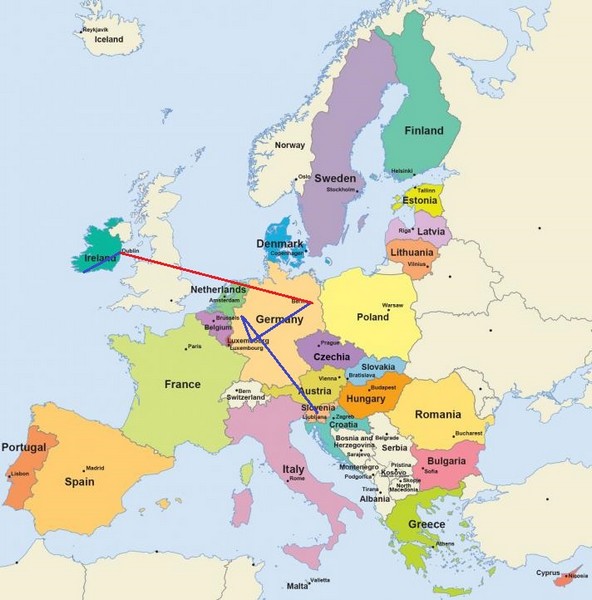
I flew to Dublin, then to Berlin (red line), and home from Ljubljana. Blue lines are train and bus routes. The countries in color are European Union members.
Ireland
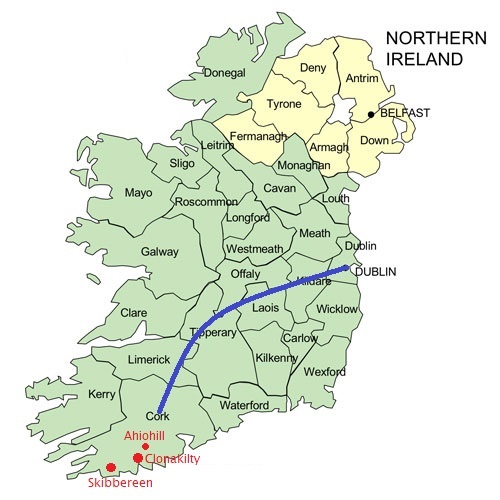
The Republic of Ireland is an independent country and a member of the EU. Northern Ireland is part of the United Kingdom. I spent two days in Dublin, then took a train (blue line) to Cork, and buses from there.
Dublin
Dublin is the capital of Ireland and its largest city. It's known for Trinity College, The Book of Kells, and pub crawls. It's not known for great weather, so I got very lucky, with warm, dry days.
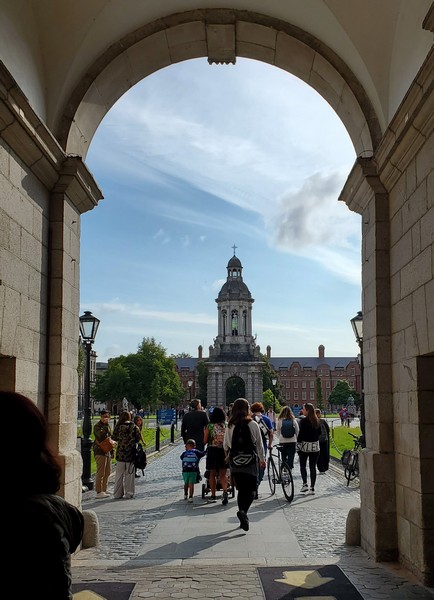
The entrance to Trinity College, Ireland's oldest university

Trinity College was founded in 1592, and boasts Oscar Wilde, Jonathan Swift, and Bram Stoker among its many illustrious alums.
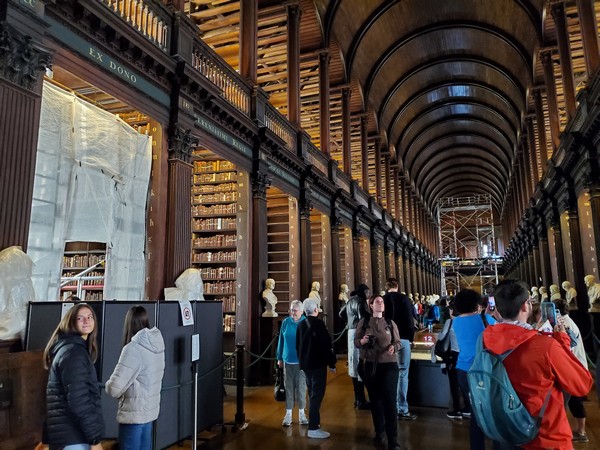
The Long Room in the Old Library at Trinity College is one of Ireland's biggest tourist attractions and holds thousands of rare and ancient volumes. The books were being moved to prepare for seismic and fire upgrades to the building, so it was kind of a historic moment to be there. You can see empty shelves, and a curtained-off area where staff were working.
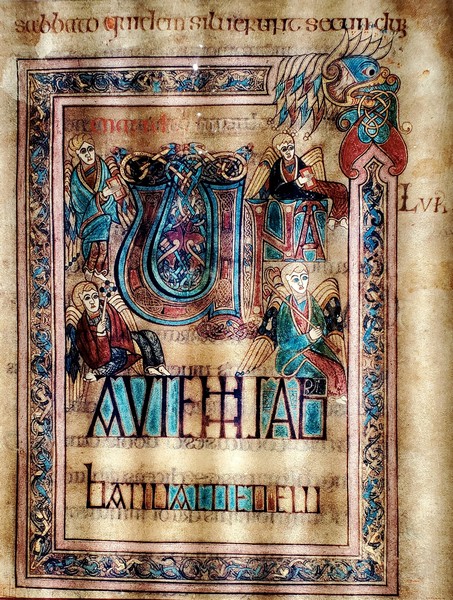
The library's most valuable possession is The Book of Kells, an elaborately-illustrated manuscript from around 800 AD. You aren't allowed to take pictures of the book itself, but there are reproduction pages on display. The actual book is every bit as vibrant as this, even after 1200 years.
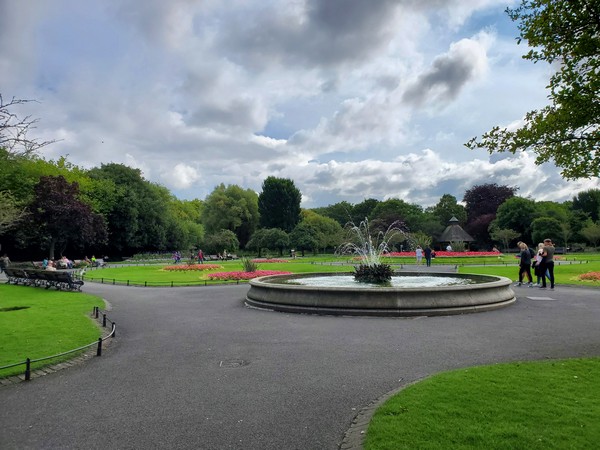
St Stephen's Green, a large park in the center of Dublin
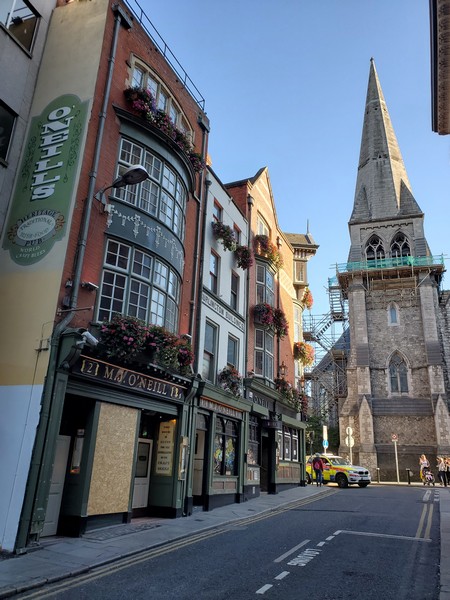
Typical Dublin street: a pub, an old church, flowers spilling from pots.

The Temple Bar Pub is one of many in the Temple Bar district, the center of Dublin's nightlife.
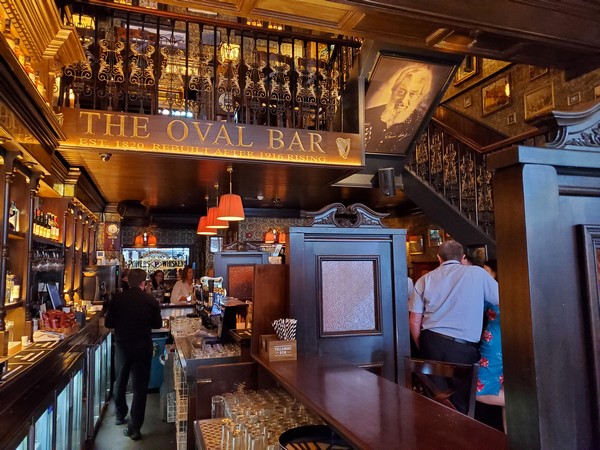
The Oval Bar, near my hostel, is supposedly one of the few traditional pubs left in Dublin, that haven't been converted to sports bars or tourist draws. The hostel recommended it for traditional Irish fare. I had soup and brown bread. I can't say I was wowed by the food in Ireland (except the scones).
Clonakilty, County Cork
I took a train and a bus to get to Clonakilty, 180 miles southwest of Dublin.

It felt very strange to be traveling on the left!
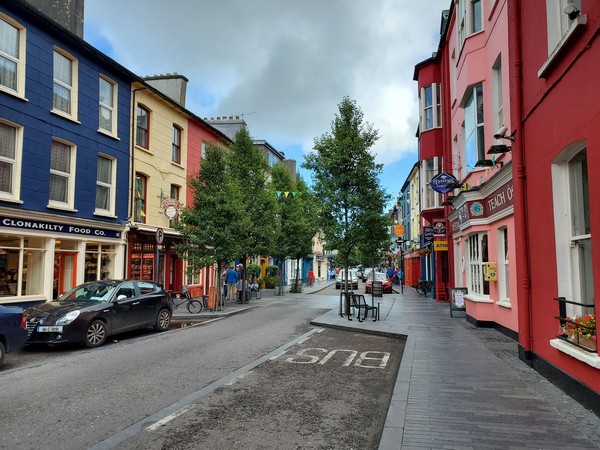
Clonakilty, population 5000, is a colorful and charming coastal town.

I rented an AirBnB room for four nights in this lovely home.

My comfortable room, with private bath, homemade cookie, garden view, and continental breakfast, was $40 a night.
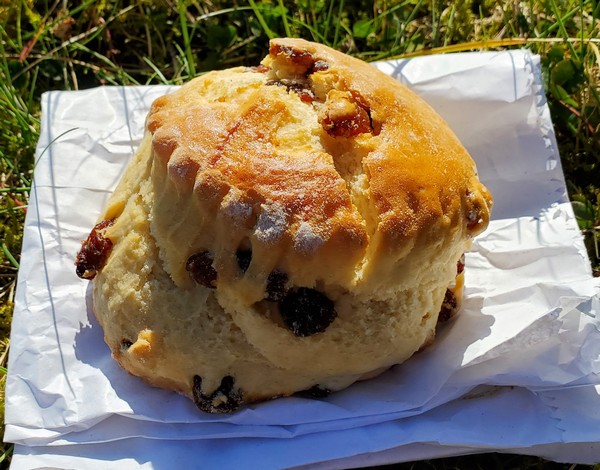
Anne made delicious Irish scones.
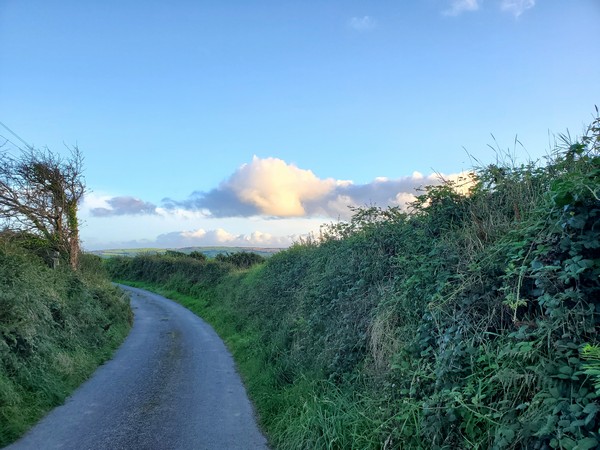
From town, it was a delightful 20-minute walk along this country lane to Anne's house.
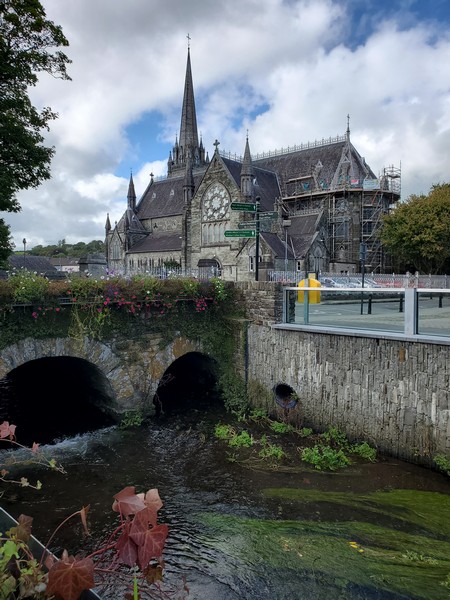
Old church in Clonakilty and the Feagle River

One day I walked along an estuary to Inchydoney Beach, a few miles south of town.
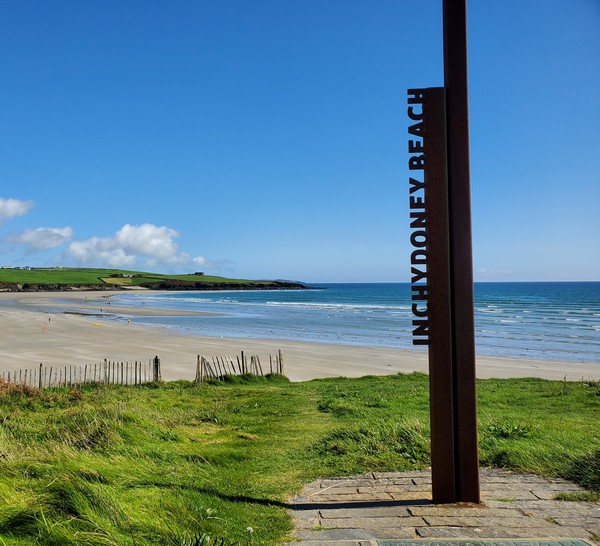
It was a warm, sunny day, and people were swimming in the Atlantic Ocean.
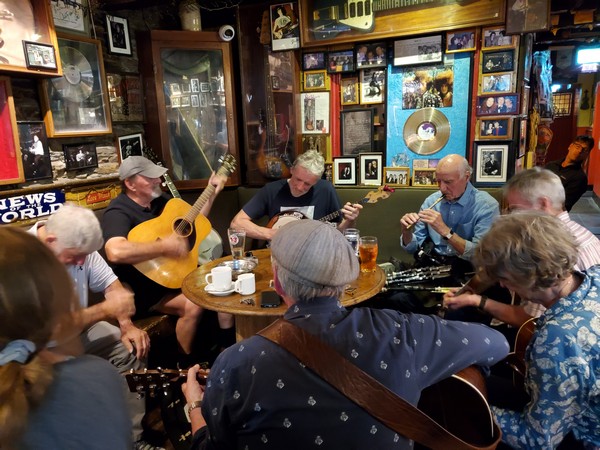
When in Ireland, one must attend a traditional Irish music session.
A traditional Irish music session at De Barra's Folk Club in Clonakilty
Skibbereen, County Cork
I came to Skibbereen to learn about the the Irish Potato Famine, and to meet with a genealogist at the Heritage Center. The famine occurred after the potato crop failed for several years due to blight. Between 1845 and 1850, at least a million people died in terrible conditions (15% of the Irish population), and more than 1.5 million emigrated. Due to the lingering economic and social effects of the Famine, migration became a part of Irish life, and fifty years later, the population of Ireland was reduced by half.
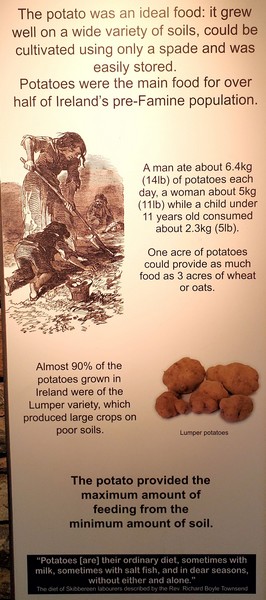
This poster is from the excellent exhibit at the Skibbereen Heritage Centre. My 3rd great-grandfather, John Donovan, was a Famine emigrant. Skibbereen was one of the worst affected areas in Ireland. Over a third of its people were lost to death or migration. The Famine generated great bitterness and anger toward the British, who exported Ireland's food and did little to help the starving people.
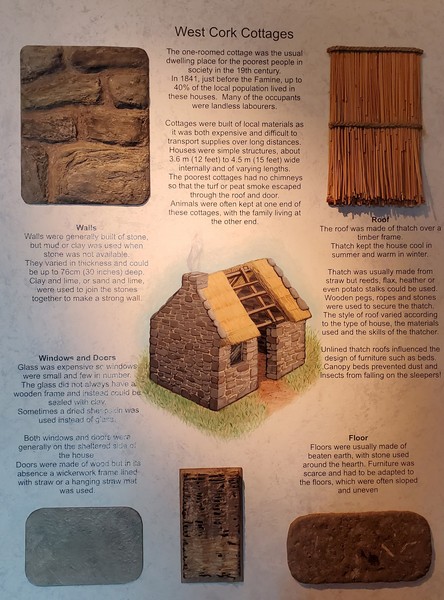
My ancestors probably lived in a cottage like this. Their name does not appear in the records of landowners or renters, so they were likely landless laborers.
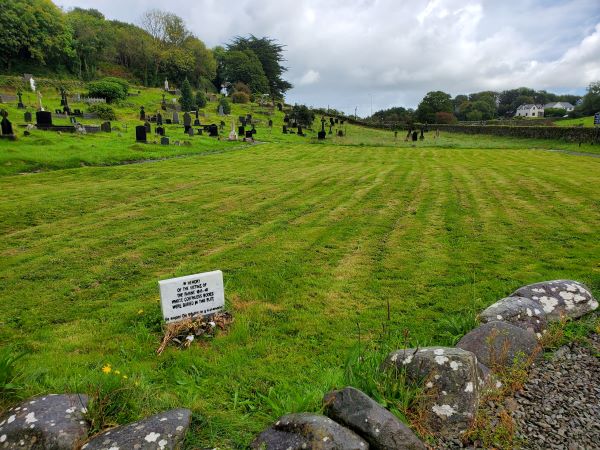
Abbeystrowry is one of three Famine burial sites in Skibbereen. Up to 10,000 unidentified souls are buried here.
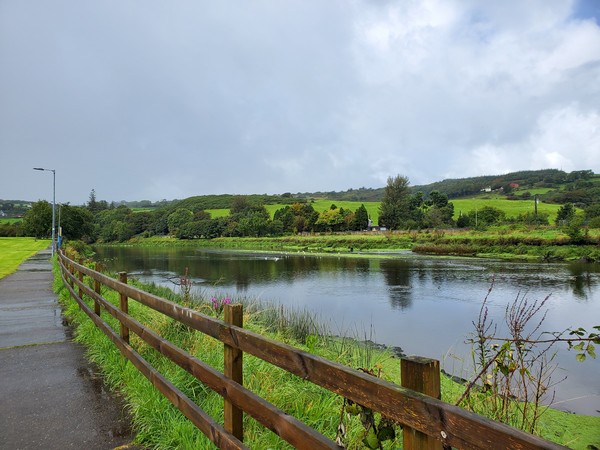
Walking along the river in green Skibbereen
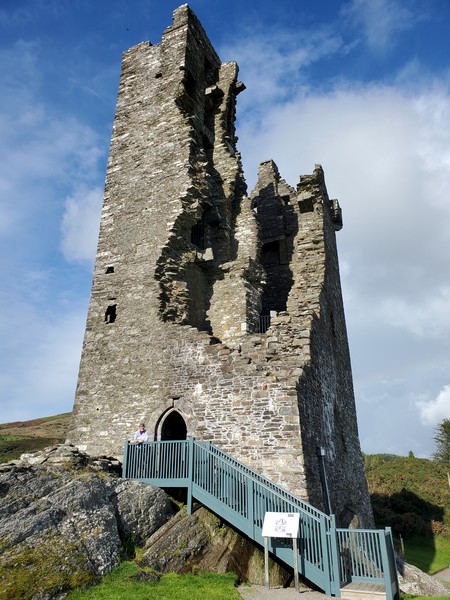
The Heritage Center genealogist was a fount of knowledge. After our session, she offered to to drive me to see Castle Donovan. This "tower house" was the seat of the O'Donovan clan in the late 1500s.
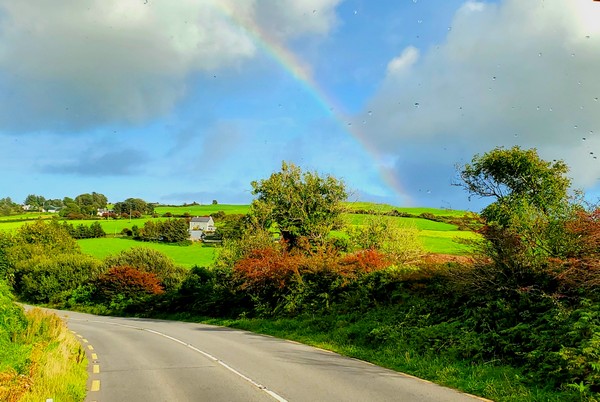
Learning about the potato famine was sobering, but on the way back to Clonakilty, this rainbow appeared to lighten the mood. No trip to Ireland would be complete without seeing a rainbow. I think the pot of gold is Ireland itself.
Ahiohill, County Cork
My 3rd great grandfather, John Donovan, was born in 1814 in Ahiohill (pronounced AH hee ohl), 20 miles from Skibbereen.
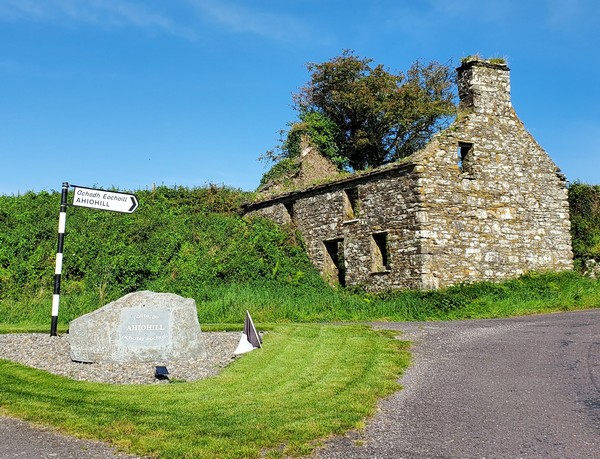
Entrance to the tiny hamlet of Ahiohill. No one knows how old the stone house is. 70 years ago it hosted a huge card game on Friday nights. Later it became a grain store for the nearby corn mill.

Ahiohill has a tavern and a few houses.

I happened to be in Ahiohill during the annual Harvest Fair, held near the town, so I walked to the fair on this country road. Paths like this make me feel I could walk forever.
As I walked past this field, the cows came running over. Apparently they are curious animals.

Deirdre is Secretary of the Ahiohill Tidy Town group. (Tidy Towns are a thing in Ireland. Volunteers tidy up their towns, and compete for national recognition, in the process creating community, a sense of pride, and lovely towns.) I found Deirdre online and she helped me plan my trip, so it was lovely to meet her in person. I'm wearing a tag that says I am the 3rd great granddaughter of John Donovan, born in Ahiohill in 1814. It was a great conversation starter, but I didn't meet any Donovans there. I did meet many nice people, and I got a sense of what the area was like 180 years ago (more trees, more bogs).
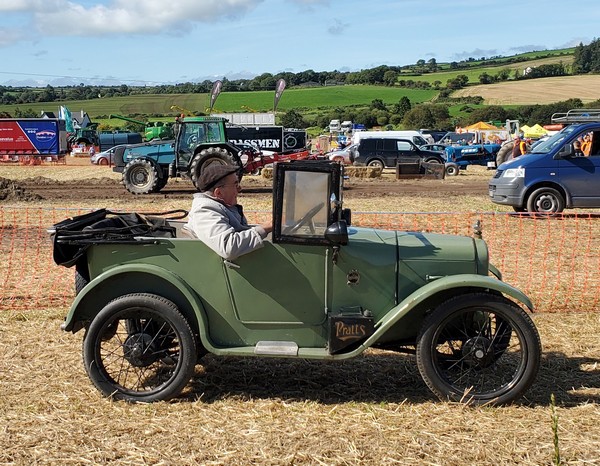
The fair featured vintage cars and farm equipment, food, games and rides, a dog show, booths selling things like hurling sticks, and lots of people having fun.

Parade of vintage farm equipment
Demonstration of a 1910 thresher made by the Laurence Donovan company in Cork
Tractor Pull at the Harvest Fair. Souped-up antique tractors compete to see who can pull a weighted sled the farthest. It's surprisingly fun to watch!
Germany
After returning to Dublin I took a flight to Berlin (only $71 on Ryan Air). My ancestry is mostly from Western Germany. I identified several towns I wanted to visit, and as luck would have it, I had friends nearby as well! But first I wanted to see Berlin, a city that had long been on my wish list.

Berlin
Many friends had raved about Berlin, and I had to see for myself. I was not disappointed. I loved the architecture, the history, and walking along the river.
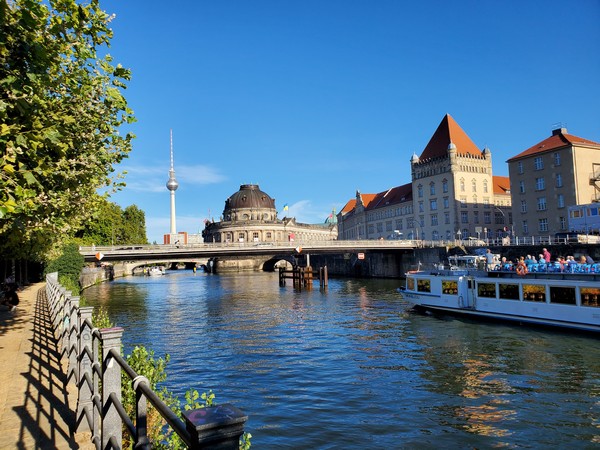
The River Spree, the domed Bode Museum, and the Berlin Radio Tower (Funkturm Berlin). Built in the 1920s, the tower is a protected monument no longer used for broadcasting.
People enjoying summer weather along the river in Berlin
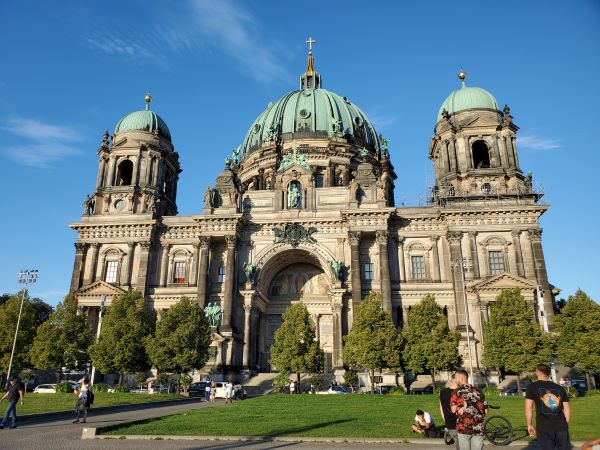
The Berlin Cathedral (Berliner Dom) is one of many gorgeous historic buildings along the river.
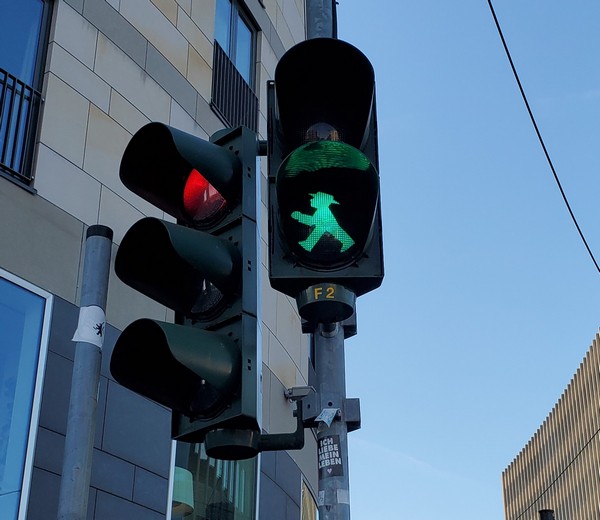
Ampelmännchen is the symbol shown on pedestrian signals in Berlin. It is one of the few features of East Germany that survived reunification. The cute symbols are so popular that a whole chain of stores has sprung up selling Ampelmännchen items.
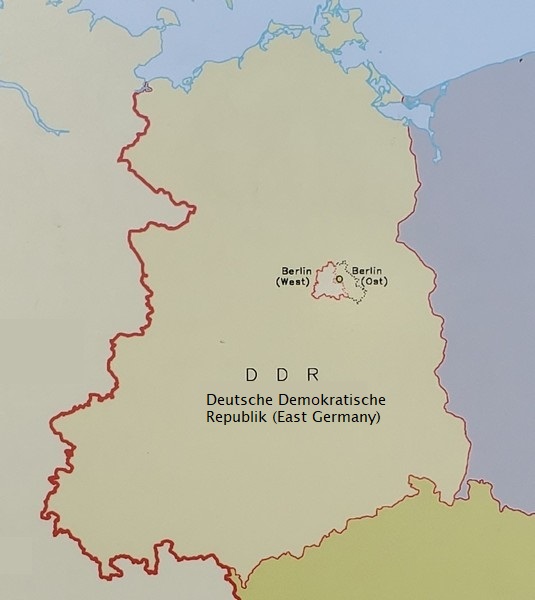
West Berlin was completely surrounded by The Wall for 28 years, from 1961 to 1989!
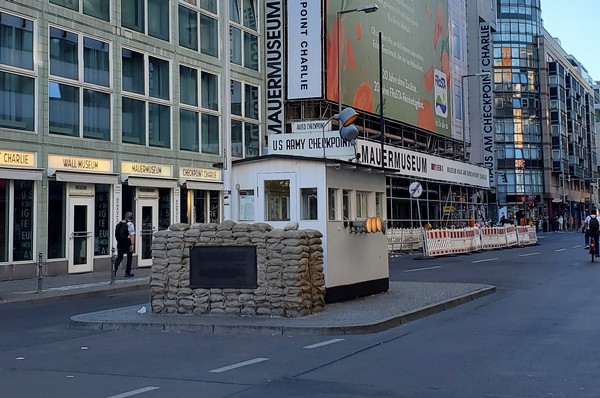
Replica of Checkpoint Charlie in its actual location. The original, which is larger, is in a museum. It was the best-known crossing point between East and West Berlin during the Wall era.
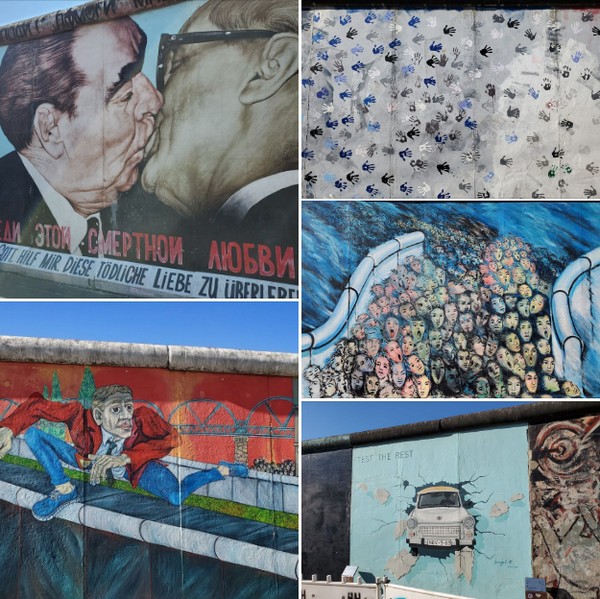
There are so many great murals in the East Side Gallery, the longest remaining section of the Berlin Wall. The most famous is the one of the two leaders kissing. It is based on an actual photograph. This was called the "socialist fraternal kiss." The men are Leonid Brezhnev, the General Secretary of the Soviet Union at the time, and Erich Honecker, the General Secretary of the Socialist Unity Party of the GDR.
Clockwise from upper right: Handprints in remembrance of the fact that The Wall was in the death zone in the GDR and could not be touched; Checkpoint Charlie on the day of the fall of the Berlin Wall; A Trabant, the well-known car of East Germany, breaking through The Wall as a reminder of the many East Germans who tried to flee to the West; Man escaping over The Wall while people in East Berlin wave goodbye.
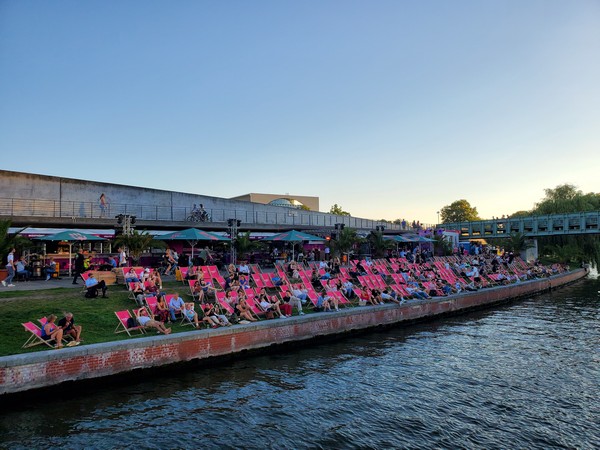
The river is lined with welcoming parks like this one.
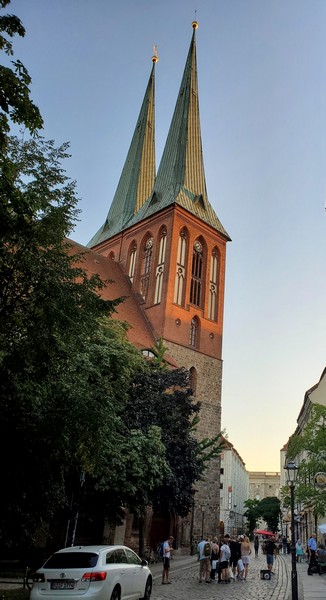
Nikolaiviertel is the restored medieval quarter in the oldest part of Berlin, founded around 1200.
A very talented musician (String Mockingbird) playing in the Lustgarten on a warm summer evening in the gorgeously-restored Prussian heart of Berlin.

The Reichstag is the German parliament building.
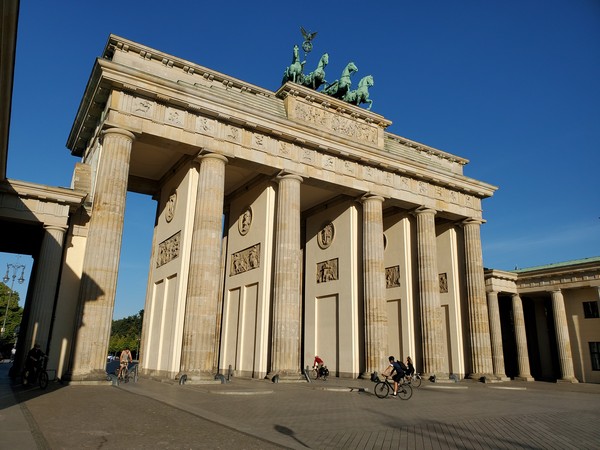
The Brandenburg Gate. During the Wall era, it was located in the restricted area, inaccessible to both East and West Germans. Now it is a symbol of German unity.
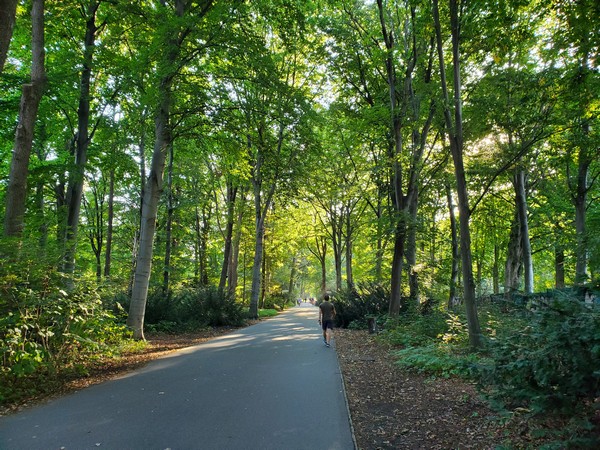
The wooded and path-laced Tiergarten is Berlin's largest park.
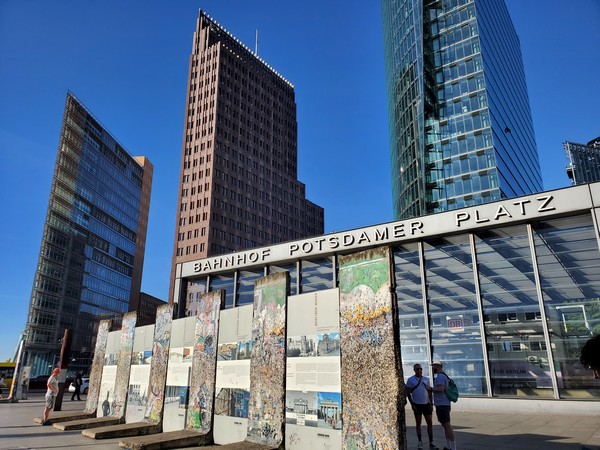
Potsdamer Platz was razed after WWII, and remained an empty space between East and West Berlin. Post-Wall, it was redeveloped into a modern architectural showpiece reconnecting the two halves of the city. Pieces of the wall have been left standing.

This is one section of the powerful "Monument to the Murdered Jews of Europe." Germany is trying very hard to make sure this history is never forgotten.

An evening boat cruise is a great way to see the heart of the city.
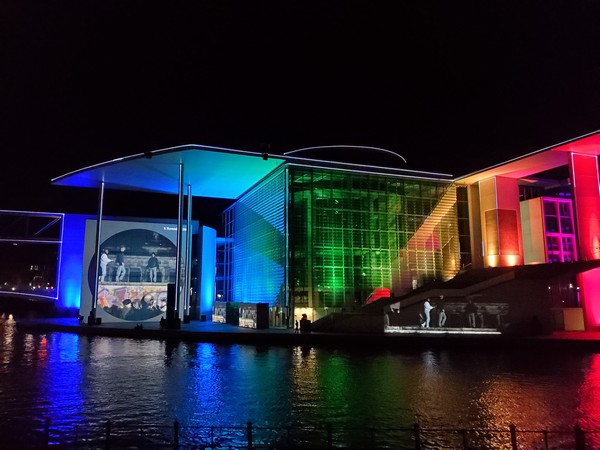
A riverside film and light show depicts the history of Berlin. This particularly moving scene showed the fall of The Wall. The film makes the point very powerfully that walls are bad! (Are you listening USA?)

Packed riverside cafes on a warm summer evening.
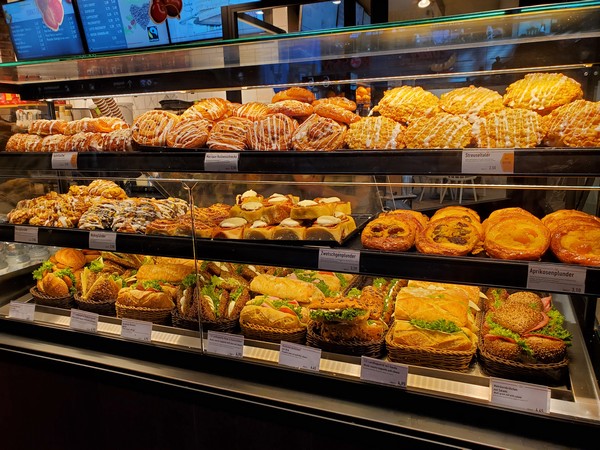
In addition to enticing pastries, bakeries also sell hearty and inexpensive sandwiches (lower shelf): bread or roll with a variety of meats, cheeses, or vegetables.

When it was time to tear myself away from Berlin, I took a train to Mainz, near Frankfurt. This is the lower level of the enormous but user-friendly Berlin train station.
Mainz, Rhineland-Palatinate
I visited friends in Mainz, then rented a car and drove to several ancestral towns nearby. The Rhineland-Palatinate (one of Germany's 16 states) is known for forests and hiking trails. It's close to the French border, and was in fact occupied by France in the early 1900s. Before that it was part of the Kingdom of Prussia.
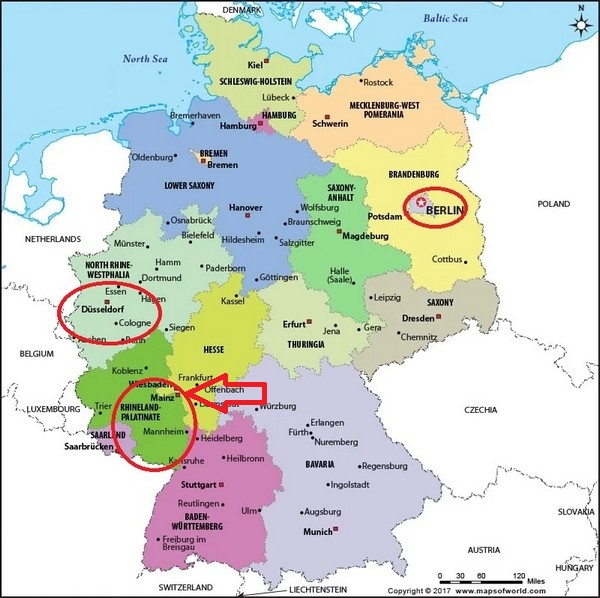
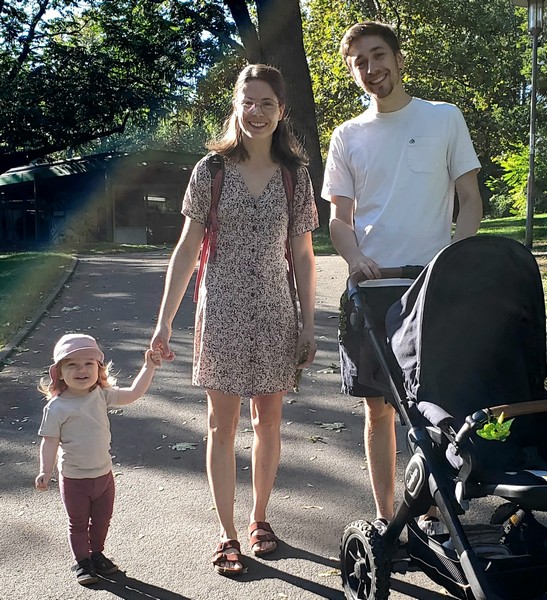
Christopher and Sarah were delightful guests in our AirBnB room six years ago. Now they have adorable 18-month-old Mathilda. They are both medical students.
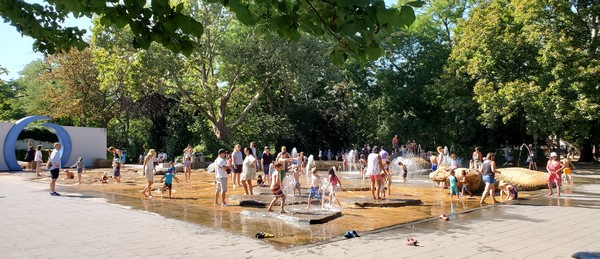
One of the great things about staying with people is that you can see what their lives are like. The splash park near their apartment is a huge hit with local families on a warm Saturday evening.

I learned about Abendbrot, which means "evening bread." It's a cold meal of breads, cheeses, meats, spreads, pickles, fruits, and vegetables.
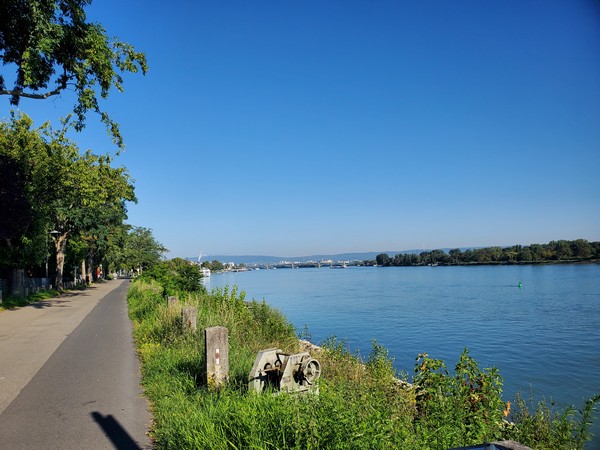
From Christopher and Sarah's apartment, it's a half-hour walk along the Rhine River to the center of Mainz. I feel a connection to this river because some of my ancestors traveled its length in 1734 en route to America.
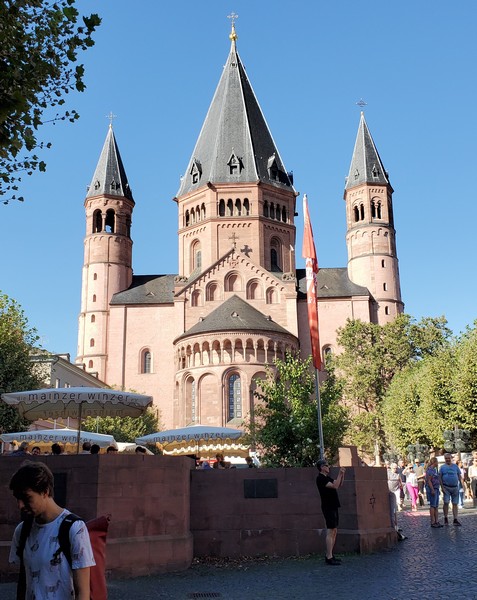
The Mainz Cathedral, built 1000 years ago, sits at the heart of this lovely city on the Rhine River.
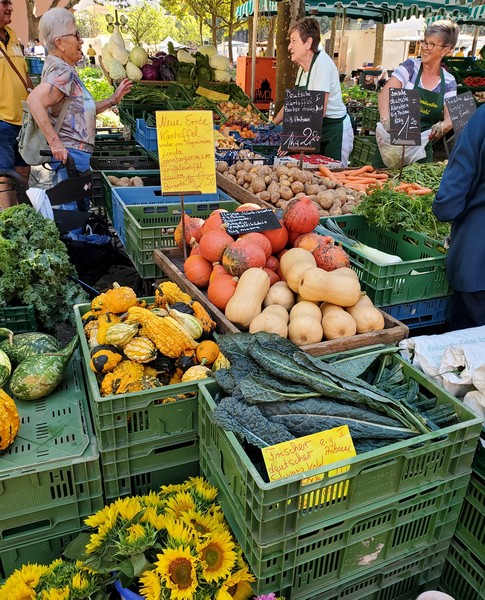
The Saturday market in Mainz
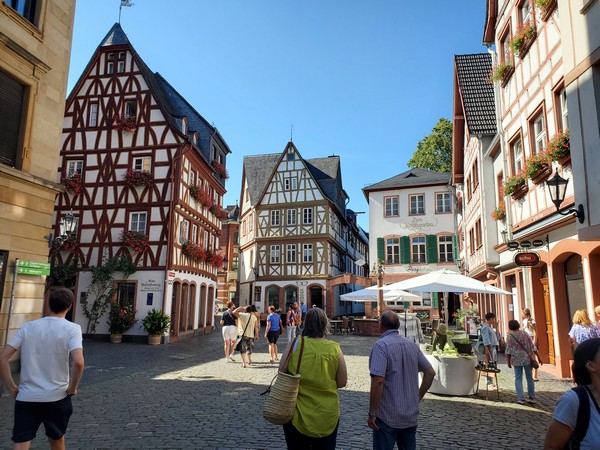
The old quarter in Mainz. The house on the left was built around 1500.
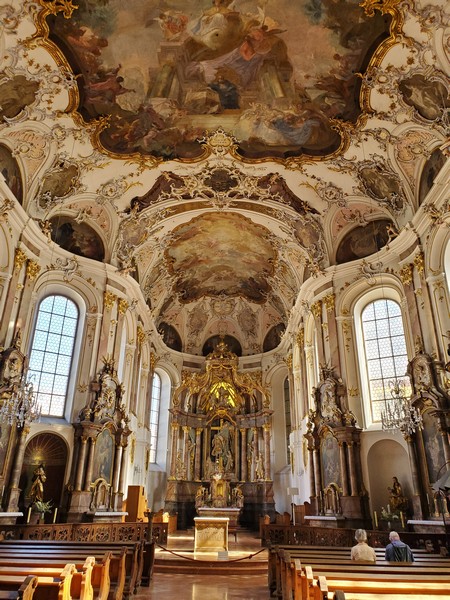
The rococo interior of St. Augustine's church
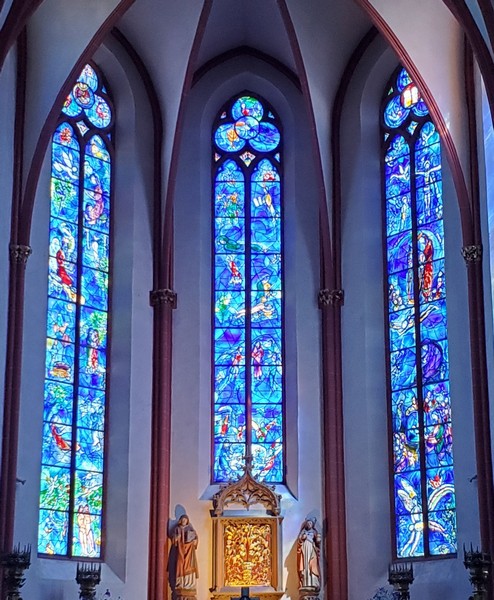
Three of the nine ethereal blue stained-glass windows in St. Stephan's church in Mainz created by Russian-Jewish artist Marc Chagall. They are a symbol of Jewish–Christian reconciliation.
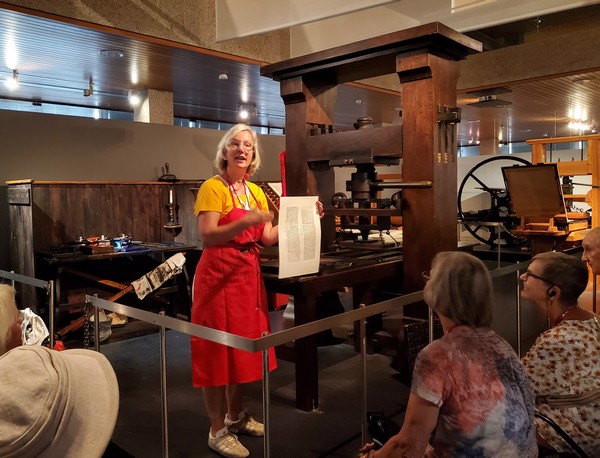
Demonstration of a press at the Gutenberg Museum in Mainz. It's a thrill to see his earliest books, from the 1450s, but no photos are allowed.
Ancestral towns
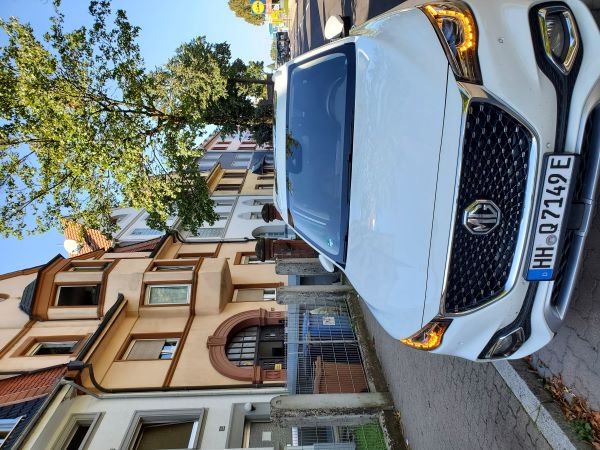
I rented this MG EHS Plug-in Hybrid and drove 90 minutes to Pirmasens. I paid a bit extra for an automatic transmission, because I haven't driven a stick shift in over 40 years!
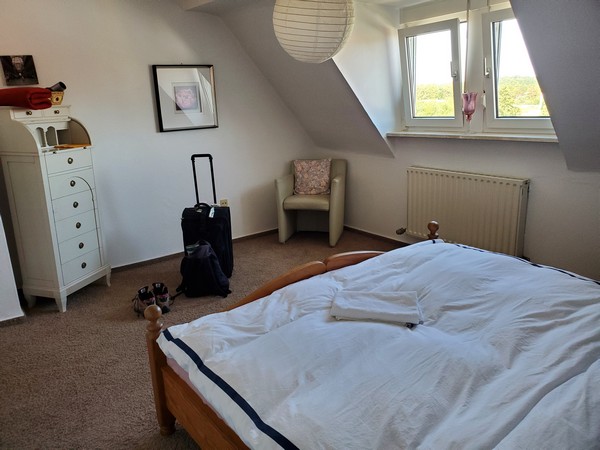
My spacious, comfortable Airbnb room cost $37 a night. This was home base for visiting nearby ancestral towns.
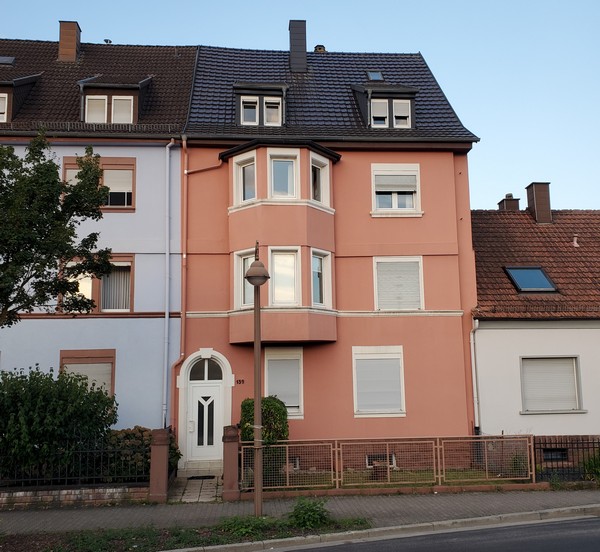
My room was on the top floor (the two small windows on the left).
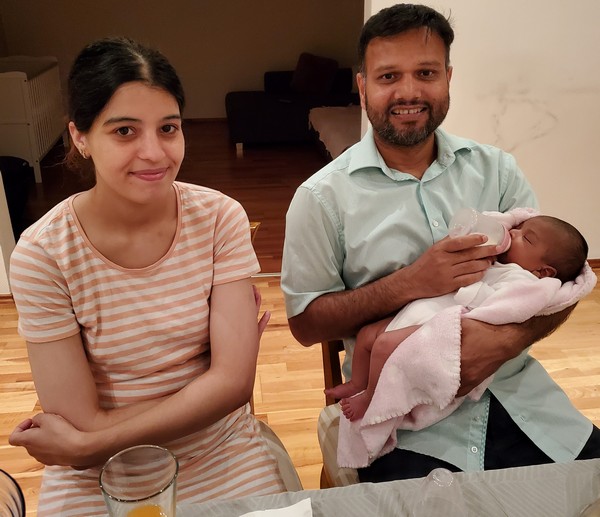
My very kind hosts were Siham from Morocco, Mohammad from Bangladesh, and their one-month-old daughter.
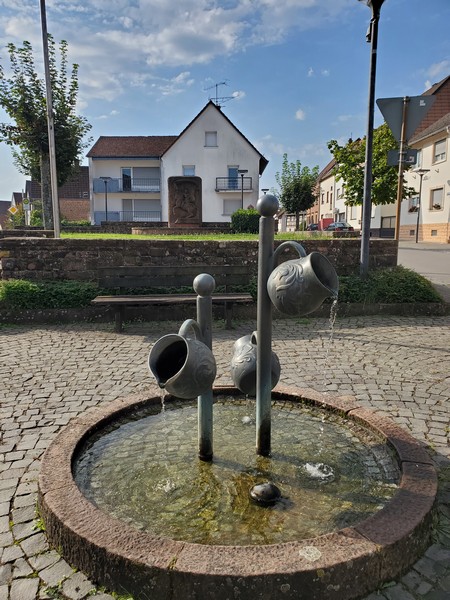
My first visit was to the small village of Clausen. My Von Der Linn great great grandparents left here in 1852, with two small children in tow, to come to New York.
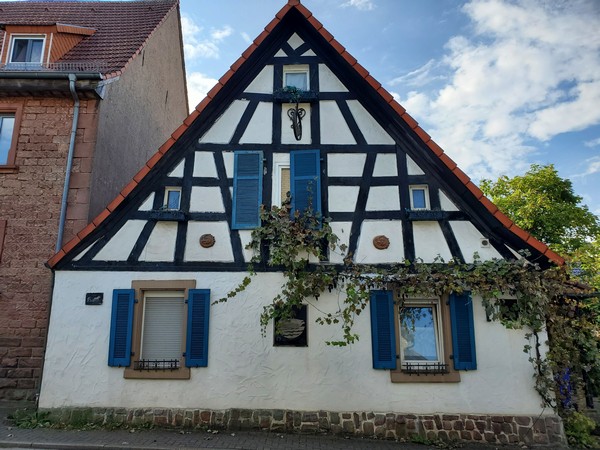
None of my ancestors' original homes are still standing, but this house was probably around when they lived here.
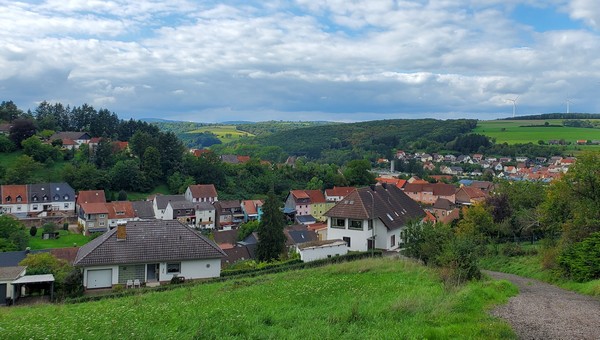
Rammelsbach, a tiny town 30 miles north of Clausen. My maternal great grandfather Julius was born here in 1878 and left for New York in 1899, at age 21, probably for economic reasons.
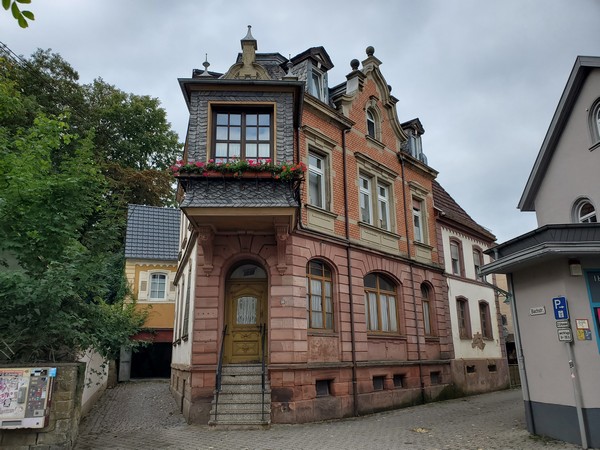
Kusel is a larger town just a mile from Rammelsbach, so Julius probably spent time here.
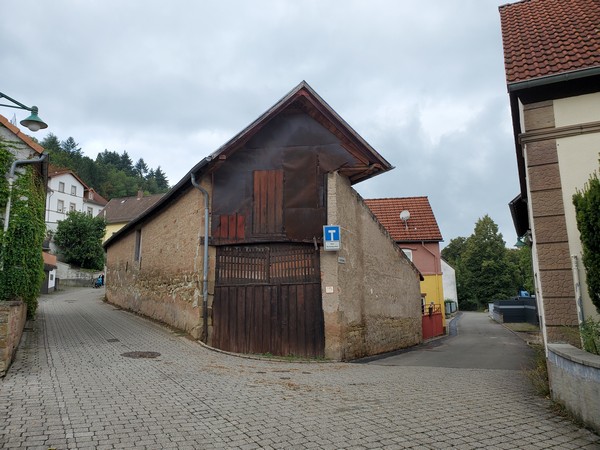
Old buildings like this one were probably around when Julius lived here.
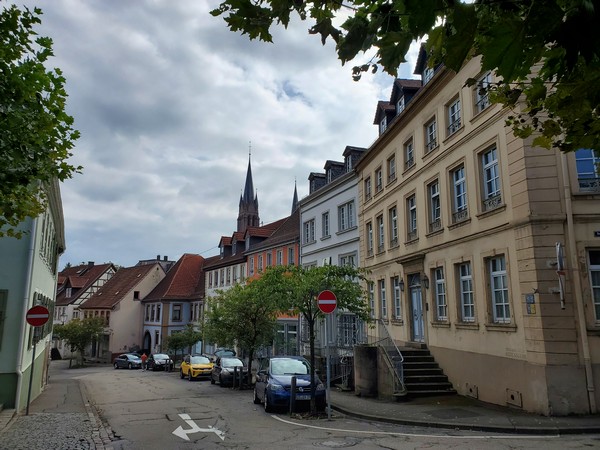
More old buildings in the heart of Kusel. The church was built after Julius left.
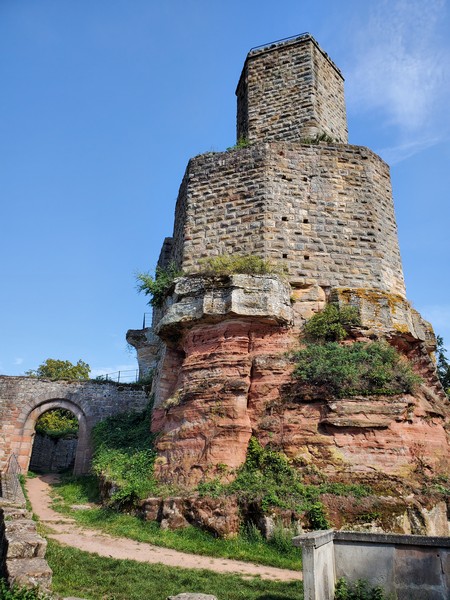
Each day, after visiting an ancestral town, I explored the area. Gräfenstein Castle in Merzalben was built on a rock outcrop in the late 1100s.
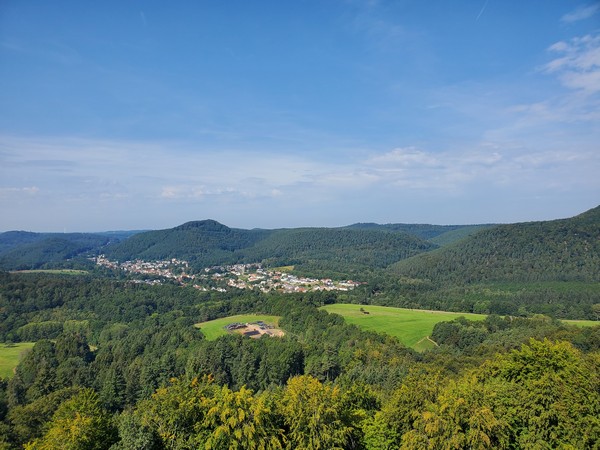
The castle gazes down upon the village of Merzalben.
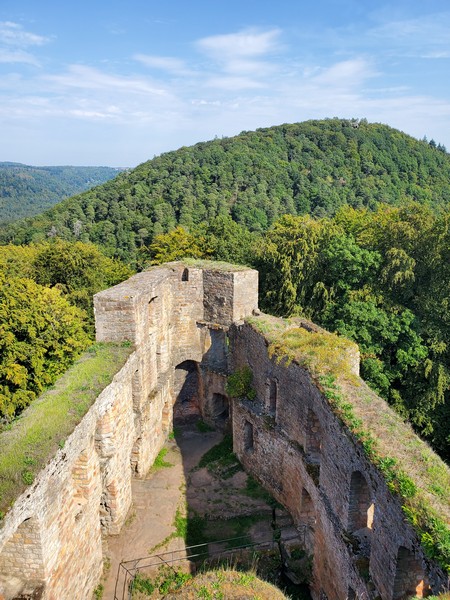
There's a sweeping view of the surrounding forest from the top of the tower.

Lichtenberg Castle near Kusel, built around 1200, has cafes, museums, a youth hostel, and grand views of the surrounding countryside.
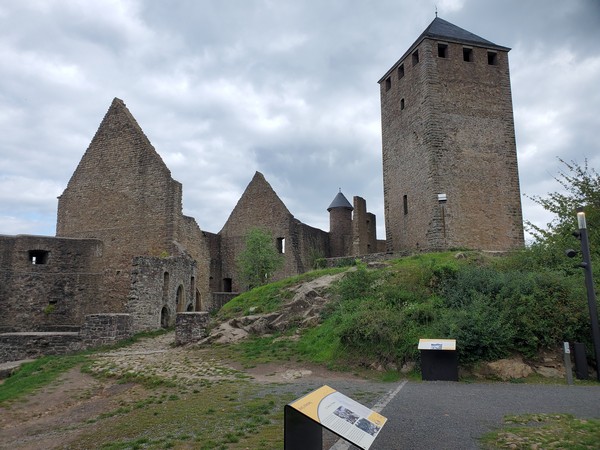
Lichtenberg castle
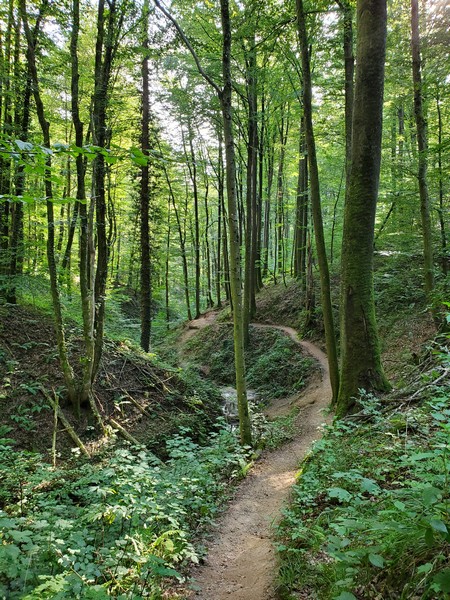
The tourist information office recommended two local hikes. This is the forested part of the beautiful Hexenklamm (Witches' Gorge) trail.
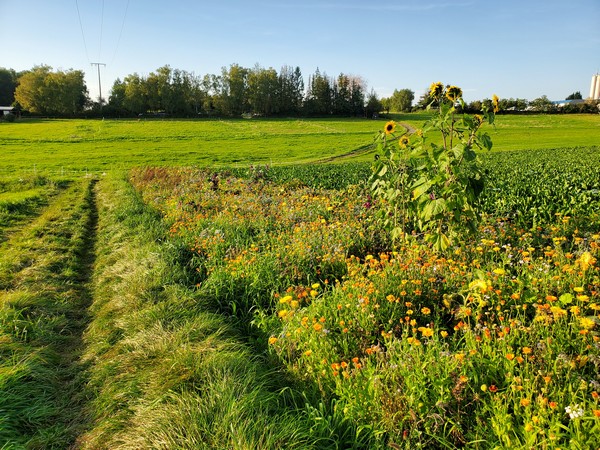
The Hexenklamm loop also included meadows.
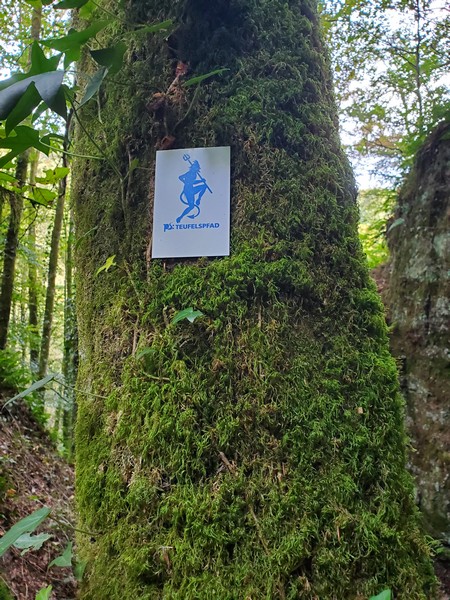
I also hiked the Teufelspfad (Devil's Path) trail. Signposts help you find your way.
Wegberg, North Rhine-Westphalia
After dropping my rental car in Mainz, I took trains to Wegberg, near Düsseldorf.
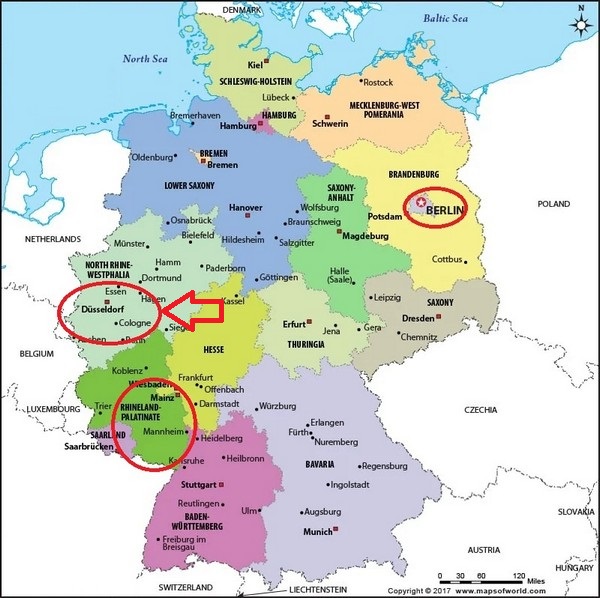
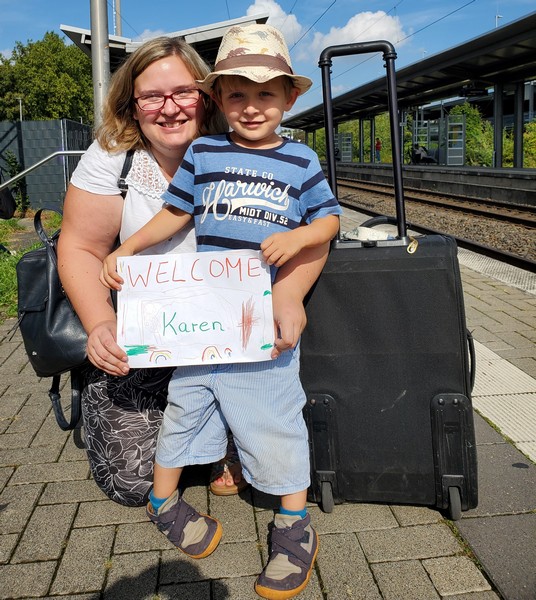
My emotional welcome to Wegberg. Julia is the daughter of Peter, a guy I met in Greece in 1980 (who sadly died six years ago). Her son, Louis, is 4. The last time I saw Julia was 11 years ago.

Wegberg is a lovely small town with green spaces and walking trails everywhere.
Düsseldorf
While Louis was in preschool, Julia and I visited Düsseldorf.

This wealthy city has a cafe-lined promenade along the Rhine River.

The 450-year-old Rathaus, or Town Hall

It was mushroom season, and there were fungi galore at the Carlsplatz market.

Hearty breads for sale in a bakery. In my opinion, German bread is the best in the world.
Burg Linn, Krefeld
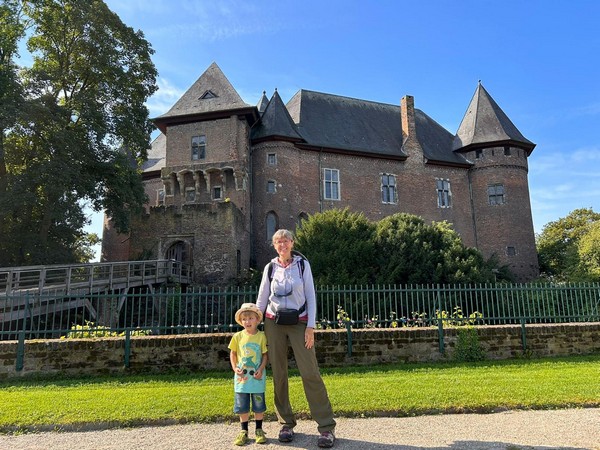
Burg (Castle) Linn, near Krefeld, Germany. My maiden name is Von Der Linn. It is possible that we originally came from Linn ("von der" means "from the"), and were serfs. Around 1691, Conradus Von Der Linn was born 175 miles south, which is a reasonable distance to have migrated on foot (probably over several generations).
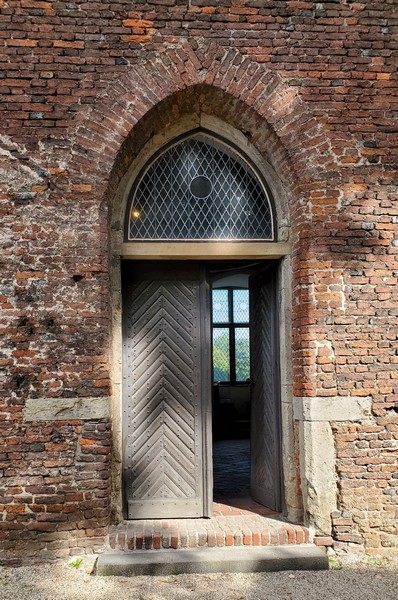
Burg Linn. I love old doors.
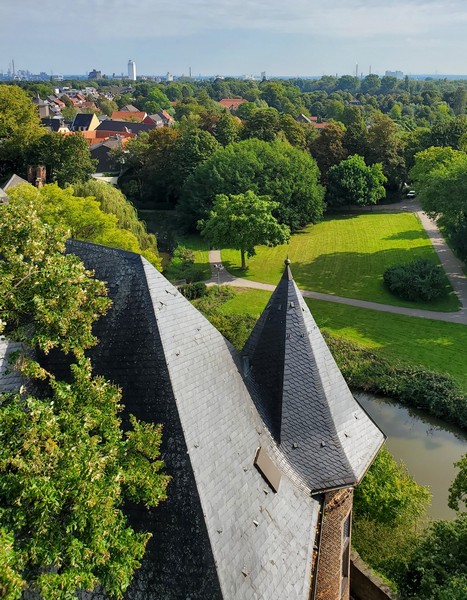
The castle looks over the tiny town of Linn (and a larger town in the distance).
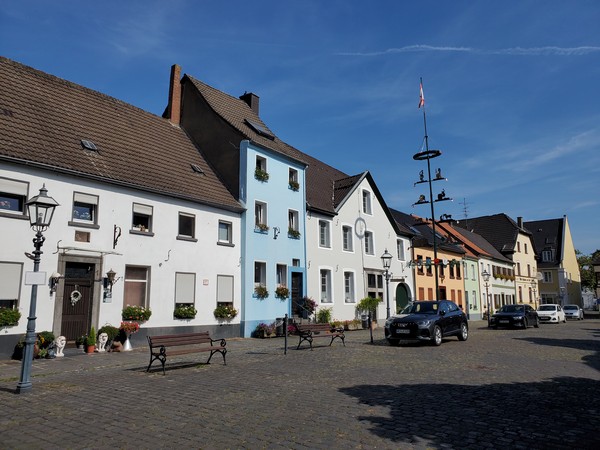
Linn was not damaged in either world war, and is now under historic preservation.
Roermond, Holland
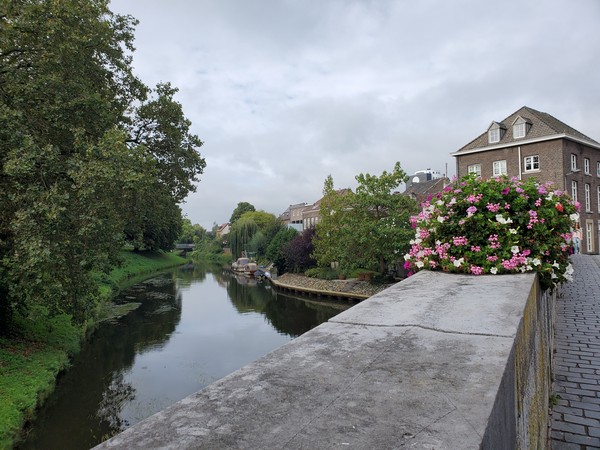
It's a short drive from Wegberg to the beautiful little town of Roermond in Holland. Germans come here to buy coffee, flowers, and fish.
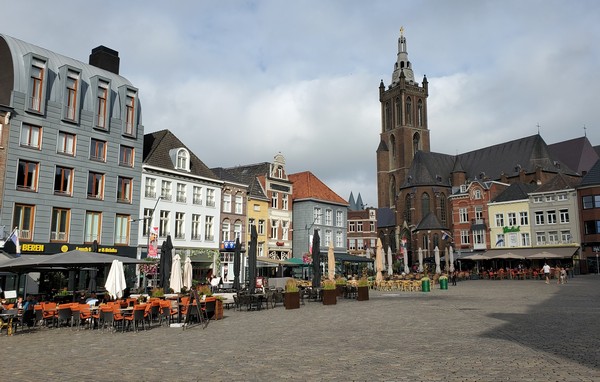
Roermond town square

Julia loves matjesbrötchen. Not realizing what it was, I said, sure, I'll try one. Oops, raw salted herring (matjes) on a roll (brötchen) - not my thing!
Cologne
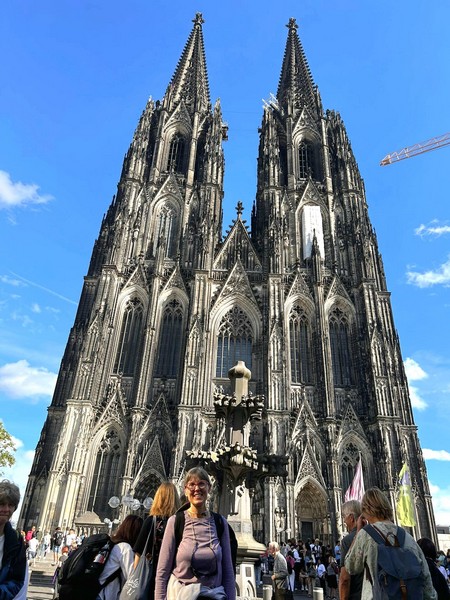
Julia, Louis, and I took the train to Cologne to see the magnificent Gothic cathedral. Construction started in 1248 and was completed in 1880.
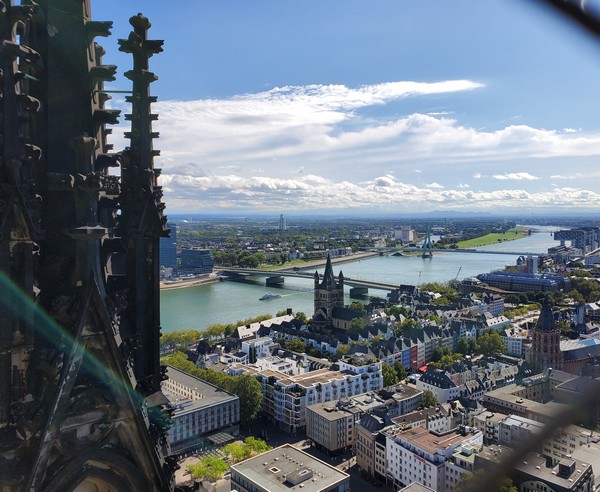
I was impressed that four-year-old Louis made it up all 533 steps to the top of the spire without flagging!
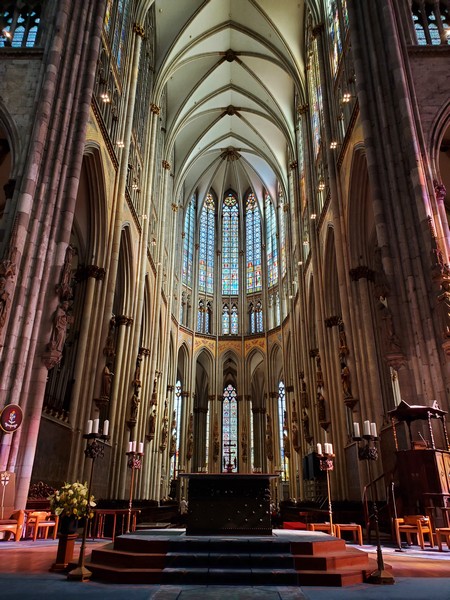
Interior of the Cologne cathedral

The high altar, installed in 1322, is a solid slab of black marble 15 feet long. The golden box behind it is the Shrine of the Three Kings, created in the late 1100s. It is said to hold the remains of the Three Wise Men. Look at the mosaics on the floor!
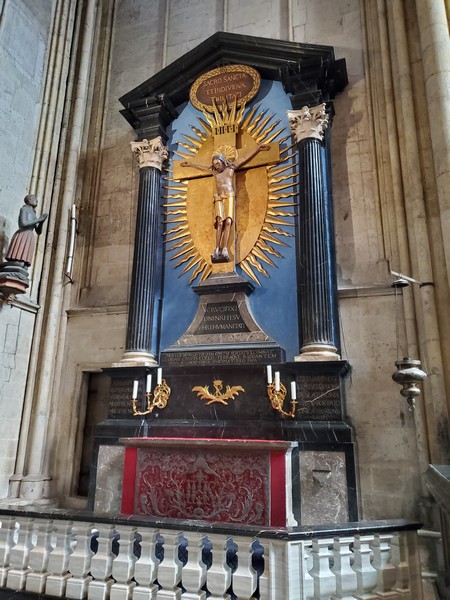
The Gero Crucifix, carved from oak, was probably commissioned around 960. The Baroque surround was added in 1683. The Christ figure is 6 ft 2 in high.
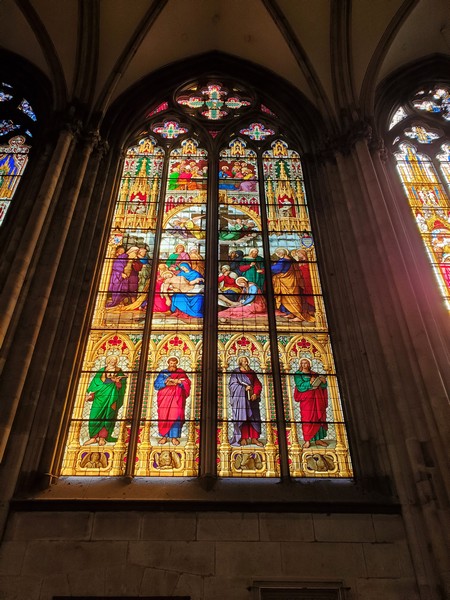
One of the vibrant windows in the Cologne cathedral
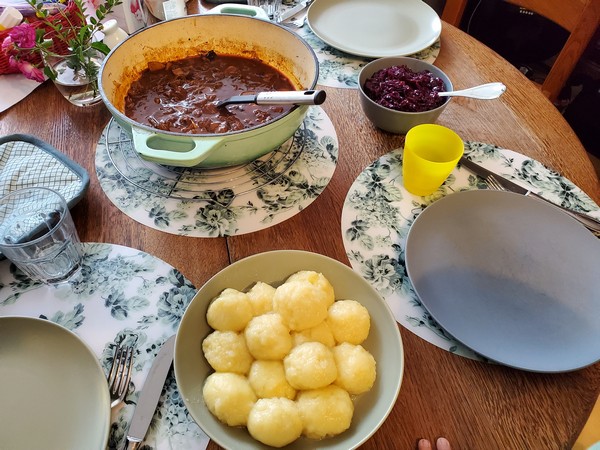
The night before I left, Julia cooked me a German going away feast: goulash with mushrooms, rotkul (slow braised red cabbage with onion and apple), and knudel (boiled potato dumplings). She is a great cook and everything was delicious.
Slovenia
I spent two weeks in this northernmost of the former Yugoslav countries. My main goal was to visit the grave and town of my maternal great great grandparents. I also took the opportunity to visit the capital city (Ljubljana, pronounced loo blee AH nuh), the coast, and the mountains. Slovenia wowed me with its scenic beauty and friendly people.
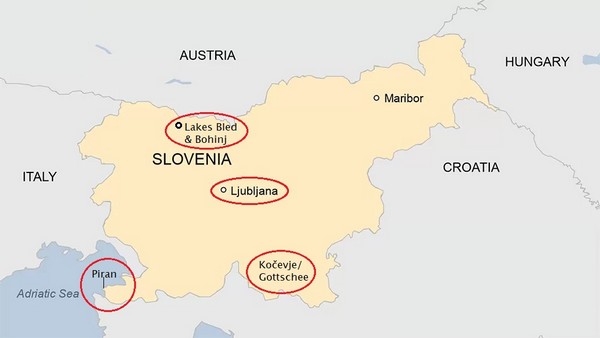
Ljubljana
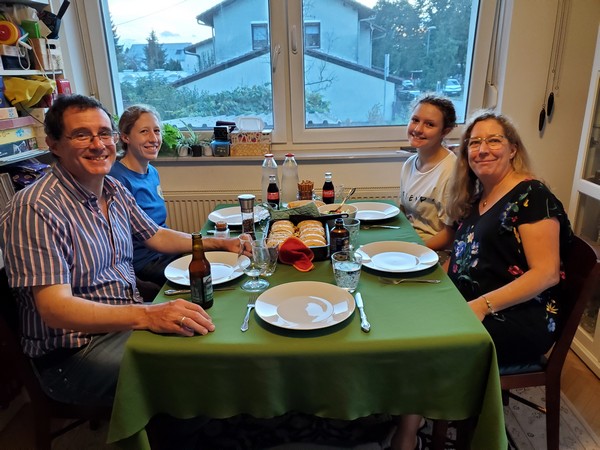
I met Donald through genealogy research. He's an American linguist, translator, and genealogist who lives in Ljubljana and teaches at the university. He and his wife, Dawn, a music educator, graciously offered to host me for two nights at their home, where they live with two of their three daughters. What nice people!
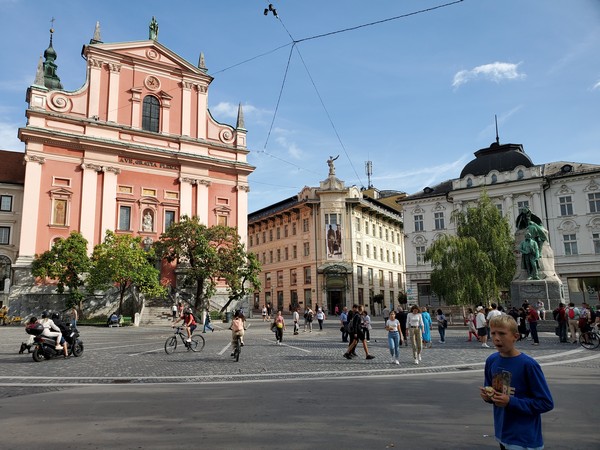
Ljubljana is a beautiful and walkable city, with a pedestrian-focused old town, a castle, a river promenade, and a big green park. Population 272,000.
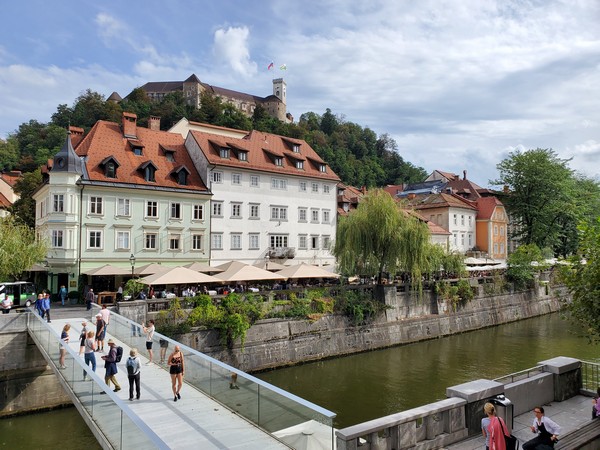
Ljubljana castle perches on a hill above the town. There are promenades and cafes on both sides of the river.

The forested trail to Ljubljana castle
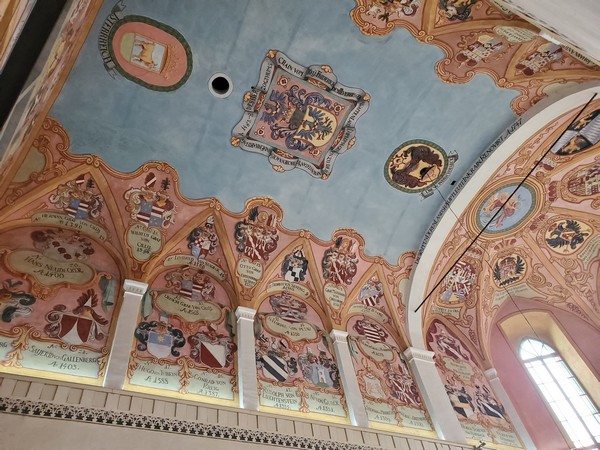
The ceiling of the Chapel of St. George in Ljubljana castle is frescoed with the coats-of-arms of the Dukes of Carniola (a historical region that comprised parts of present-day Slovenia).

Looking down on Ljubljana's old town from the castle

Wandering the cobblestone streets of Ljubljana's old town
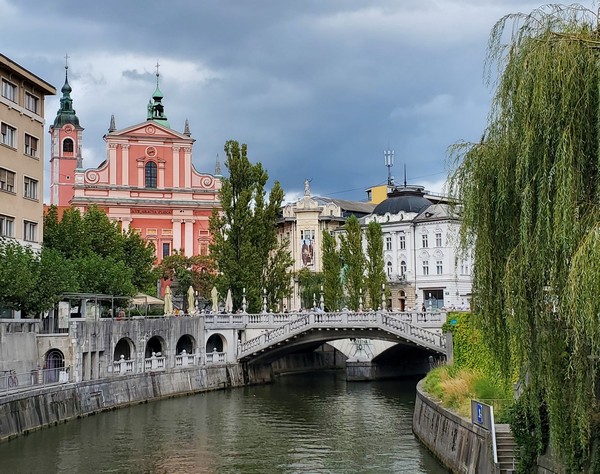
Photogenic Ljubljana
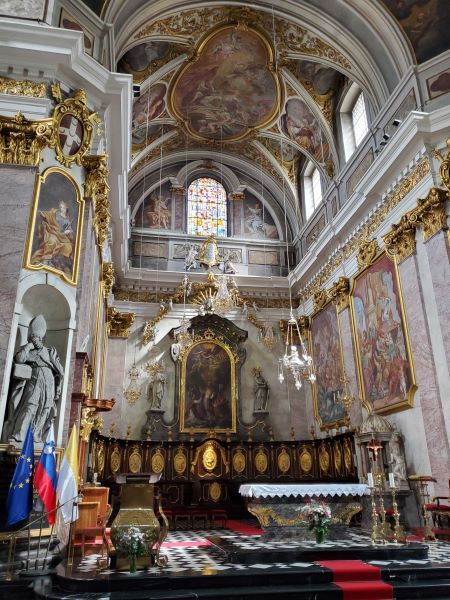
St. Nicholas church has pink marble and gilt decor, and gorgeous carved wooden choir stalls.
Gottschee
My maternal great great grandparents lived in Gottschee, a German linguistic and cultural "island" in what was then part of the Austro-Hungarian Empire, later became part of Yugoslavia, and is now southern Slovenia. Many Gottschee Germans emigrated to America, and there is still a small Gottschee population in New York.

My friend drove me to Mozelj, about an hour south of Ljubljana, to visit the grave of my maternal great great grandparents. All of their children emigrated to America. Ferdinand and Magdalena Erschen died in 1936 and 1929. That is a ceramic photo of them, still in good shape almost 100 years later! It was incredibly moving to visit these people I never met, but without whom I wouldn't be here.
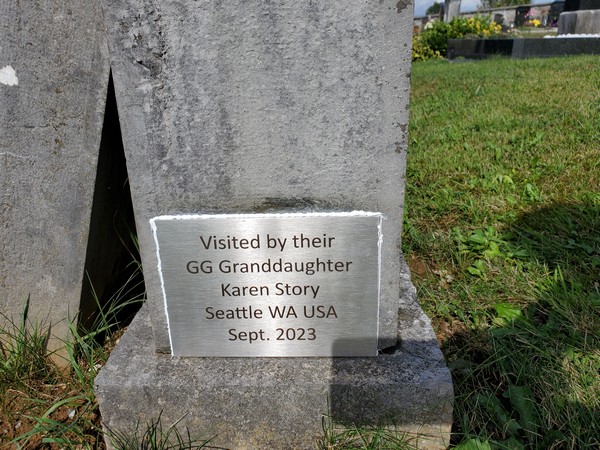
I epoxied this plaque to the plinth to let visitors know that someone still cares about this grave, and in the hope that a distant relative might try to find me online. (The epoxy will dry clear.) My friend found a local engraver for 1/10th of the price in Seattle ($20 instead of $200).
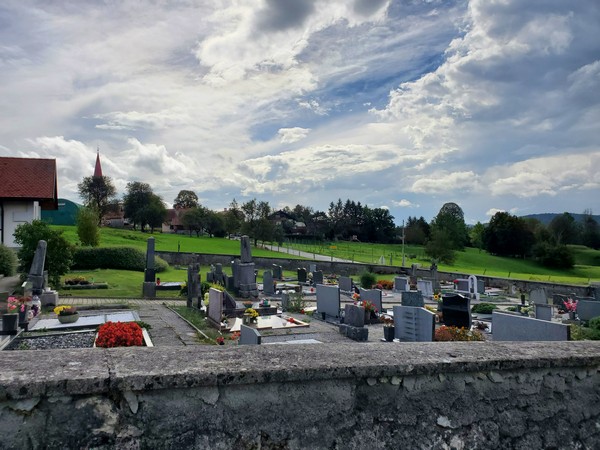
Many German graves and churches were destroyed by the Yugoslav regime after WWII, so I am very lucky that my ancestors' headstone and church survived.
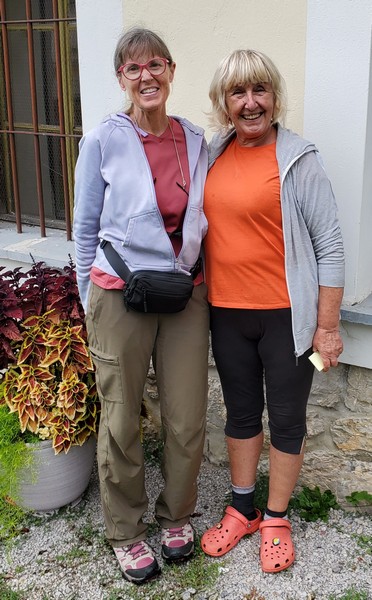
I was so grateful that my friend speaks Slovenian. He asked around the village to find someone with a key to the church. Dragica (pronounced Dragitsa) helps care for the church and proudly gave us a tour. She was so friendly! She could understand a lot of English but wasn't comfortable speaking it. I love that we are both wearing shoes that match our shirts!

St. Leonard's church in Mozelj survived because four Slovenian men protected it day and night. It doesn't look like much on the outside, but on the inside...

I never expected these riches inside a humble church in such a small village! The main altar is high Baroque, made of wood, created in 1764.

The wall frescoes were probably painted by a traveling fresco painter in the 1500s.

This old house in Mozelj was likely standing when my ancestors lived there.
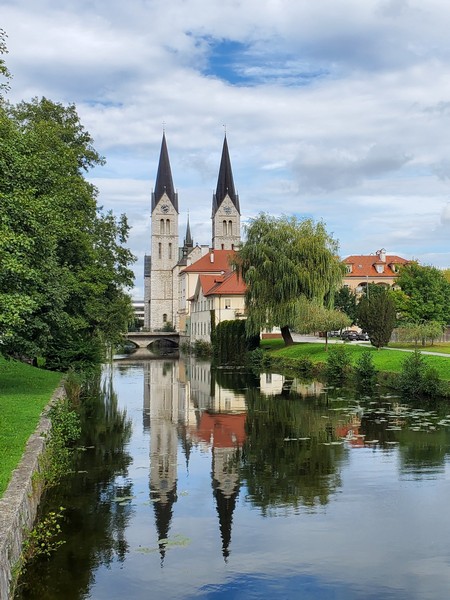
The parish church in Kočevje reflected in the Rin˛a River. This town was the center of Gottschee (Kočevje is the Slavic version of Gottschee).
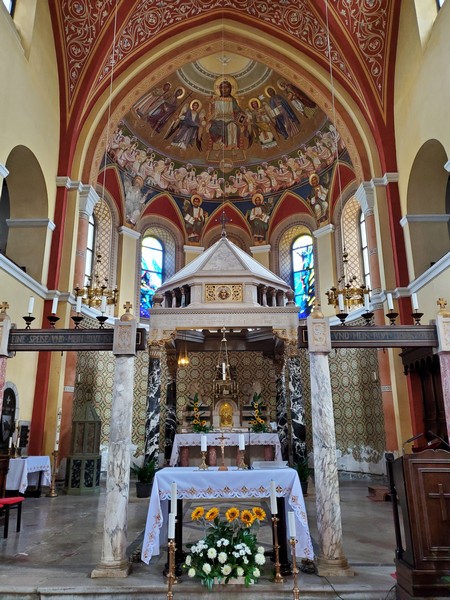
The neo-Romanesque church was built in 1903. Its covered altar and altar screen are some of very few in the Gottschee area with preserved German inscriptions. My ancestors probably visited on occasion, and its soaring, ornate interior must have felt like Notre Dame to them.
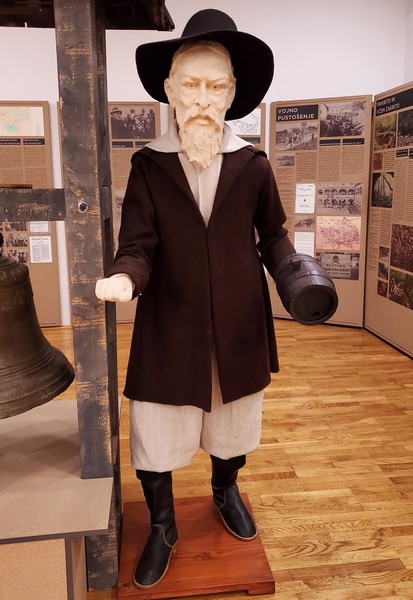
Any Germans still living in Gottschee were expelled by Yugoslavia after WWII, and no one was allowed to talk about them or their culture. Since independence in 1991, Slovenia has made an effort to honor the Gottschee culture. There is a permanent exhibit called "The Lost Heritage of the Gottschee Germans" in the Kočevje museum. Here is the traditional Gottschee men's attire.

Deep in the forest outside Kočevje is a horrible, beautiful place. It's a memorial to thousands of people who were executed by the Yugoslav regime after WWII, their bodies thrown into limestone caverns. This is one of almost 600 sites in Slovenia containing up to 100,000 people. No one was allowed to talk about it or create a memorial until after independence.
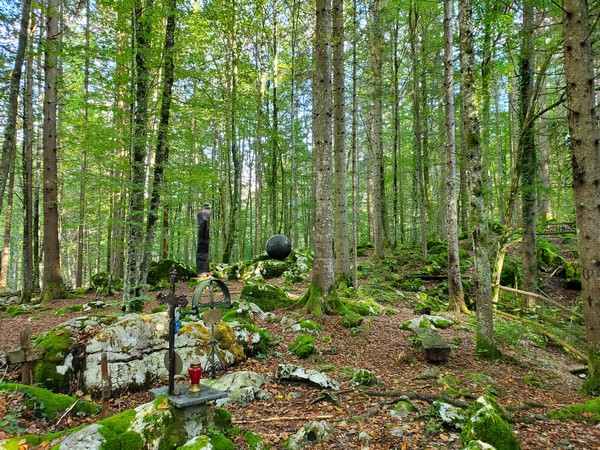
Massacre memorial site near Kočevje
Piran
From Ljubljana I took a bus two hours to Piran, on a peninsula on the Slovenian coast.
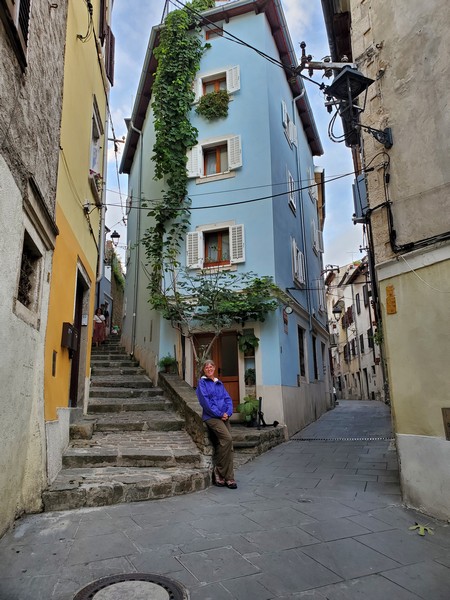
Piran is a charming maze of alleys, and one of the best-preserved historic towns in the Mediterranean. Lonely Planet calls it "a gem of Venetian Gothic architecture."

Looking down on Piran's main square and harbor

One day I walked a 20 km loop around the Piran peninsula: along the sea, up onto a cliff, through olive groves, past salt flats, and in a national park. The trail is visible on the left, and you can see the crenellations of the old town wall on the hill.
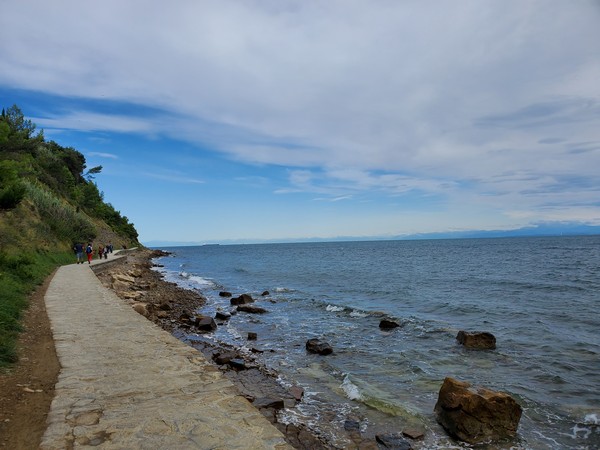
Trail along the sea
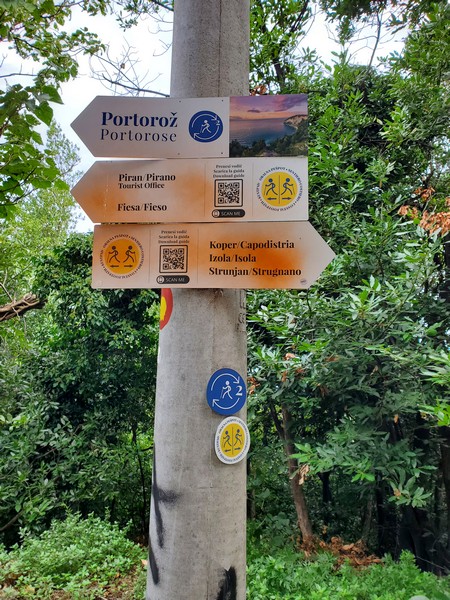
Signs help you find your way.
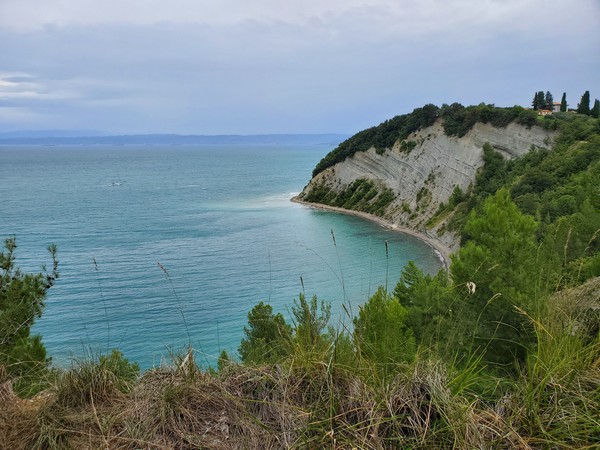
The Cliff of Strunjan is the highest cliff in the Adriatic.

View from the old wall of Piran
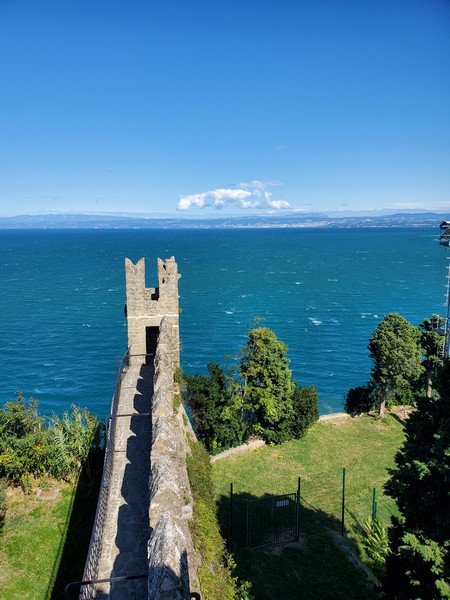
Part of the old wall of Piran. That's Trieste, Italy, across the water.
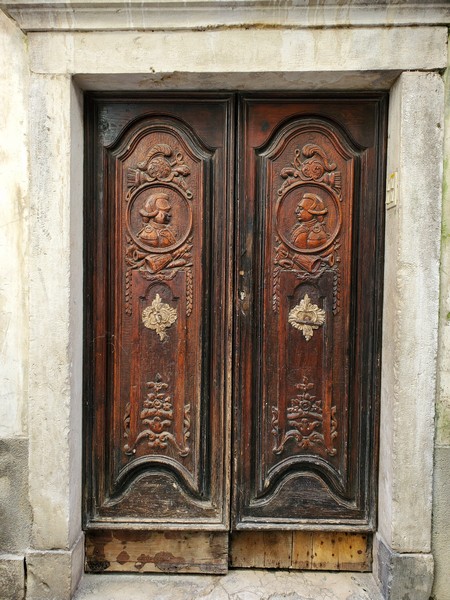
An old door in Piran
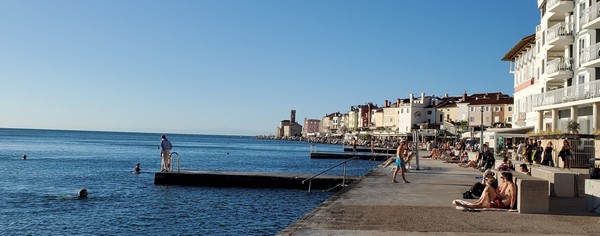
People swimming in the warm Adriatic Sea
Lake Bled
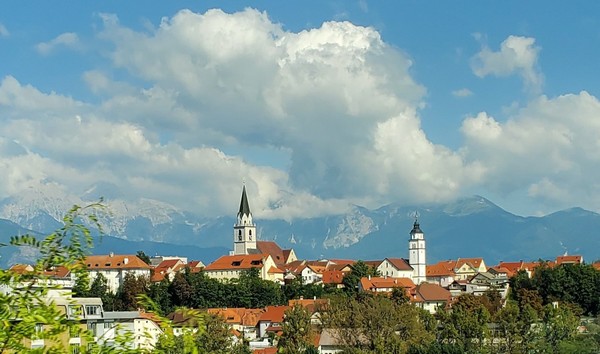
Lake Bled is an alpine lake in the Julian Alps in northern Slovenia, about an hour from Ljubljana. The scenery along the way gave glimpses of villages and peaks.
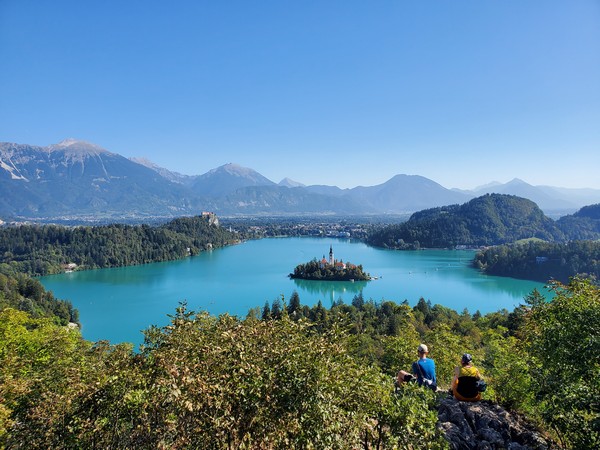
Looking down on Lake Bled from the Ojstrica viewpoint. The brilliant turquoise lake is beautiful, but what makes it magical is that it also has an island with a 17th-century church accessible by boat, a castle perched on a cliff, and a backdrop of alpine peaks. The six-kilometer walk around the lake gives you one amazing view after another.
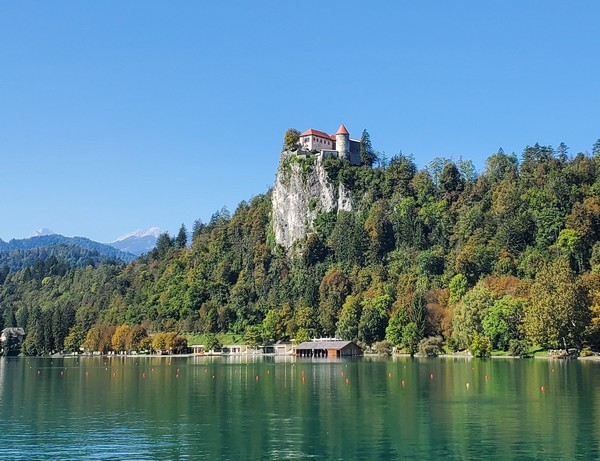
Bled Castle perches on a cliff 130 meters above Lake Bled. You can see snowy peaks to the left.
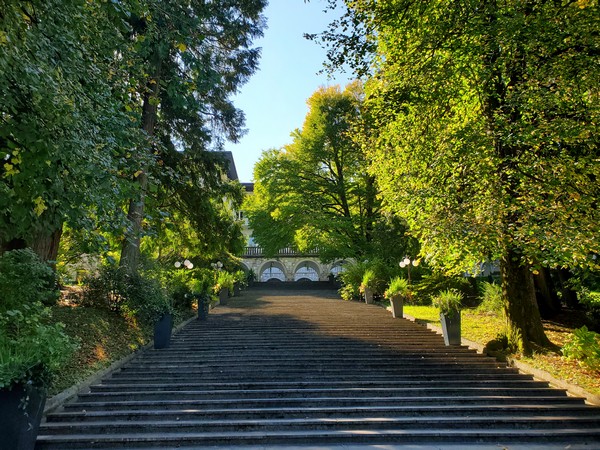
Stairs from the lake to Villa Bled, a luxury hotel that was once Yugoslav dictator Tito's summer home.
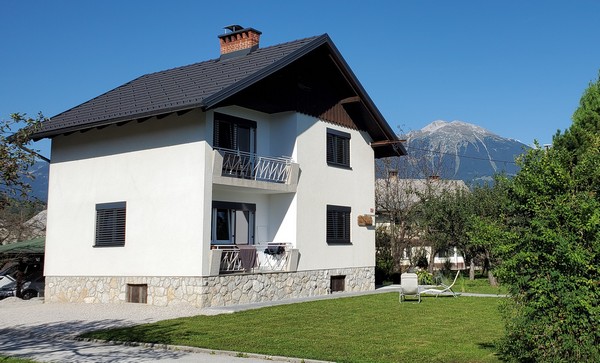
I stayed in a lovely hostel home on the edge of town. (See more info about hostel life below.)

View from Bled Castle (the arrow is my hostel)
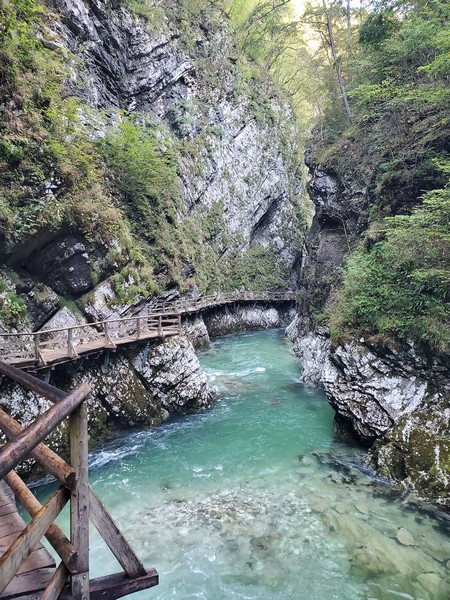
It was a 45-minute walk through villages and on paths to stunning Vintgar Gorge, where a one-mile-long wooden boardwalk clings to the rock.
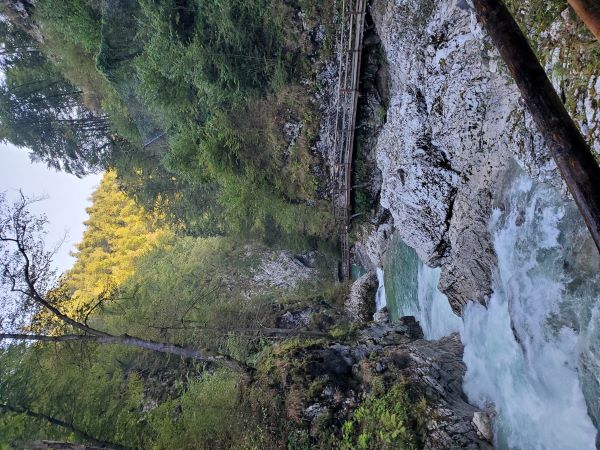
I got there when it opened at 8 AM, and almost had the place to myself. It gets crowded later in the day.
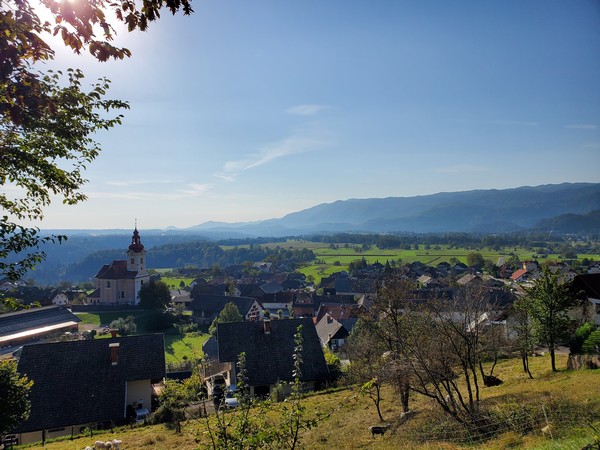
Hiking down from Vintgar Gorge. The loop walk took about three hours, and every inch of it was beautiful.
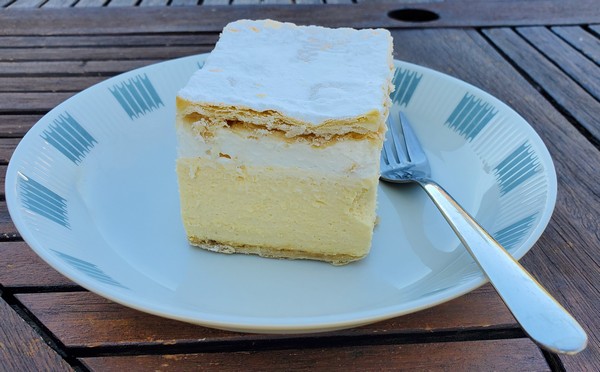
Bled is known for Cream Cake. Thin, flaky butter pastry top and bottom; light and fluffy vanilla custard; and whipped cream. Delicious! (The powdered sugar on top was a bit much for me so I scraped it off.)

Slovenia is rightly proud of its bee husbandry. Here is a typical colorful bee house on a farm.
Lake Bohinj

Peaceful Lake Bohinj, 30 minutes from Lake Bled, is popular with hikers, campers, and skiers (in the winter).

The first morning I arrived, the valley was shrouded in mist as I set off to walk around the lake.

The mist burned off quickly. The 12 km (7 mile) trail around the lake starts out in fields.

Most of the lake trail is forested.

I took the gondola up to the Vogel ski area at 5039 feet. Here you can see the gondola wires snaking up to the barely visible square building at the top.
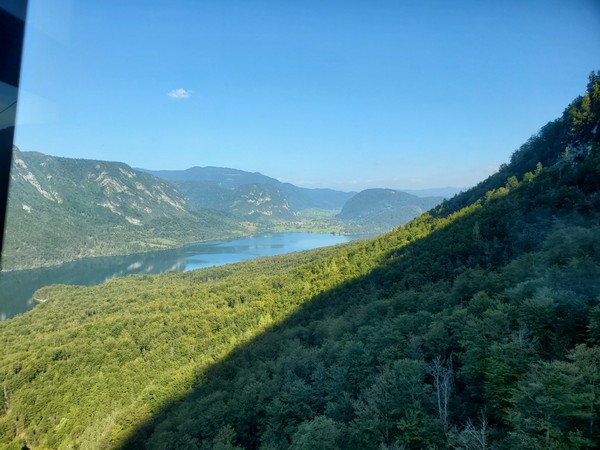
View of Lake Bohinj from the gondola. The car climbs 3100 feet in four minutes. You are basically going up a cliff face. I was terrified, but the view from the top was worth it.
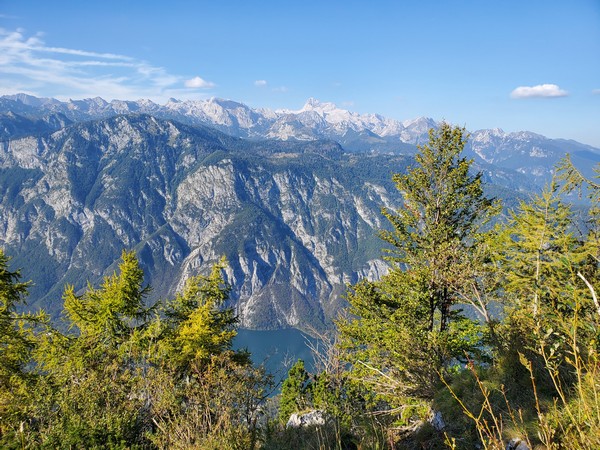
View from the Vogel ski area. 9400-foot Mt. Triglav is the highest peak in Slovenia. That's Lake Bohinj way down below.

I did several hikes during the two days I spent at Lake Bohinj (I took the bus from Bled each day). Here is a view of Bohinj from the steep and rocky Vogar trail.

The hike through Mostnica Gorge was beautiful.
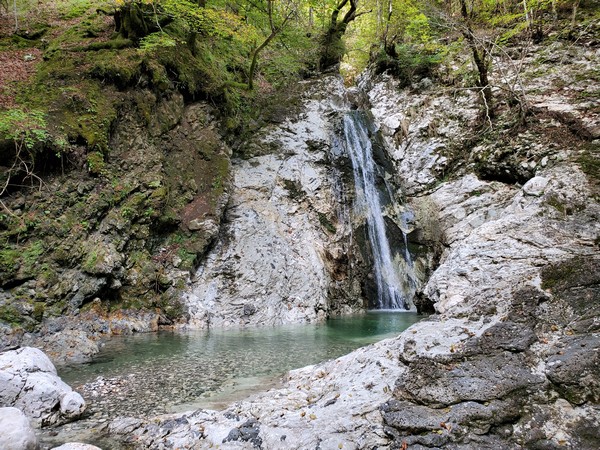
Lower Ribnica Falls
The Voje Valley above Lake Bohinj, where fat cows grazed blissfully. Click the video to hear their bells, the quintessential sound of the Alps.

My walks took me through countryside and villages, past cows, barns, and fields of cut hay, along rivers and through forests. I loved walking on the narrow lanes through villages.

A lovely picnic spot, with clean drinking water flowing out of a pipe hidden in a clever wooden spout.

Bike path along the Mostnica River near Lake Bohinj
Costs
Total cost including round-trip flight: $3120
Total cost not including round-trip flight: $2120 ($61/day)
Cost breakdown:
- Round-trip flight Seattle-Dublin/Ljubljana-Seattle: $1,000
- Lodging: $850 (12 nights with friends; 22 nights in paid lodging at an average of $39 per night)
- Groceries: not included, because I would have spent this at home
- Restaurants: $218 (includes taking hosts out to thank them)
- Site fees (museums, castles, boat ride, etc.): $114
- Flight Dublin to Berlin: $71
- Rental car + gas for three days: $255
- Buses and trains: $612
Hostels
Why do I like staying in hostels? They save money and provide common areas (and often a kitchen, so you can cook, saving even more money), where you can meet people from all over the world, have interesting conversations, and get information about the area you're visiting. Sites like HostelWorld allow you to choose a hostel that fits your travel style (no party hostels for me). People were quiet and considerate. Most dorm rooms are co-ed, but some hostels offer non-co-ed dorms or private rooms. Prices ranged from $30-$40 a night. Some include breakfast.
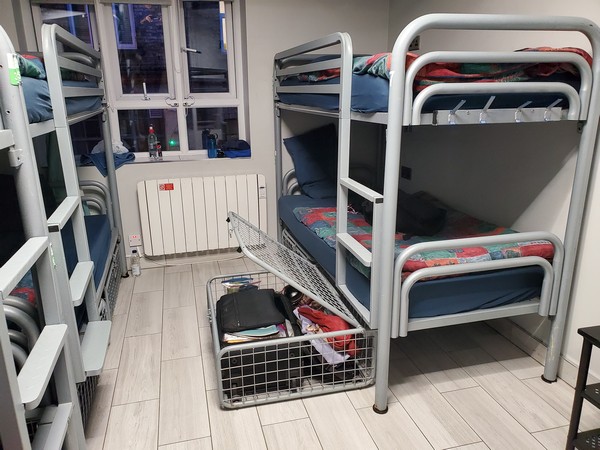
Hostel dorms have bunk beds. You can request a lower bunk. This dorm at the Abbey Court Hostel in Dublin had lockable under-bed storage bins on rollers.

Kitchen at the Abbey Court Hostel in Dublin. (It's a large hostel with many rooms.)
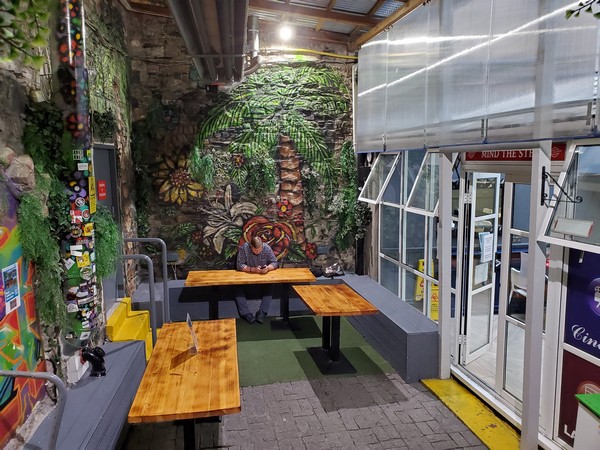
One of the common areas at the Abbey Court Hostel in Dublin

Hallway in the Abbey Court Hostel in Dublin. Hostels are not generic hotel experiences!
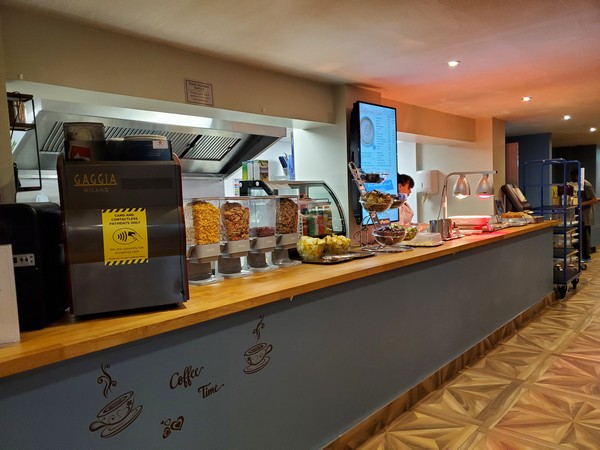
Buffet breakfast at the Abbey Court Hostel in Dublin
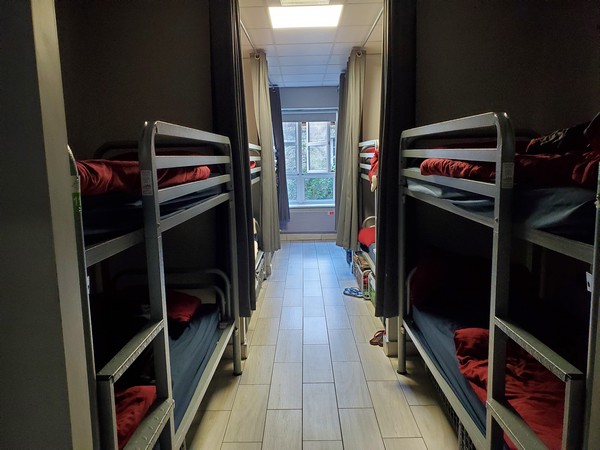
Another room at the Abbey Court Hostel in Dublin. Most hostels don't have this many bunks per room.
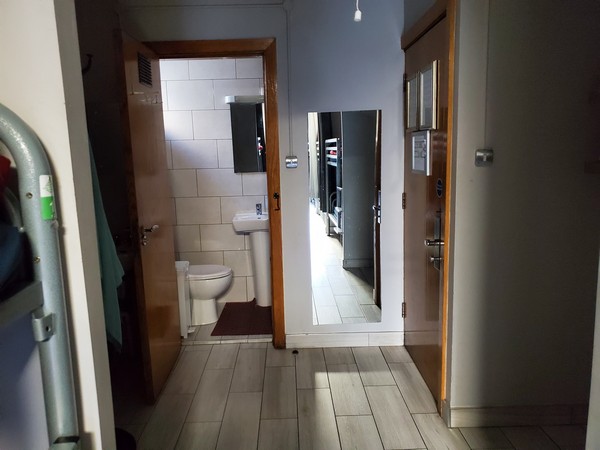
Often there is an ensuite bathroom, with additional toilets and showers in the hall. The hostels I stayed in were very clean, and provided towels and bedding.

Bright and airy six-bed dorm at the Meininger Humboldt hostel in Berlin

Berlin hostel common area leading out onto a terrace with tables
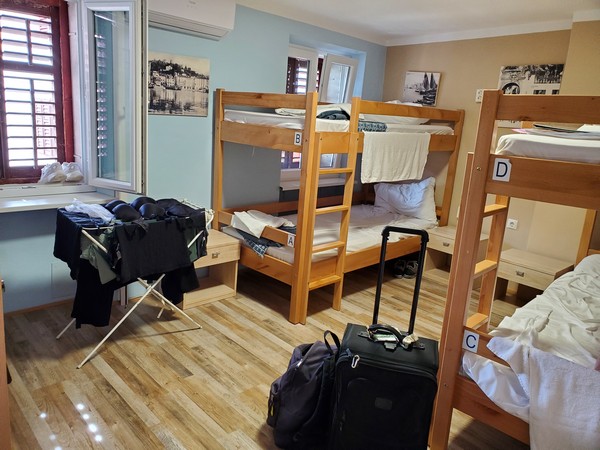
Four-bed dorm at Hostel Adriatic, Piran, Slovenia
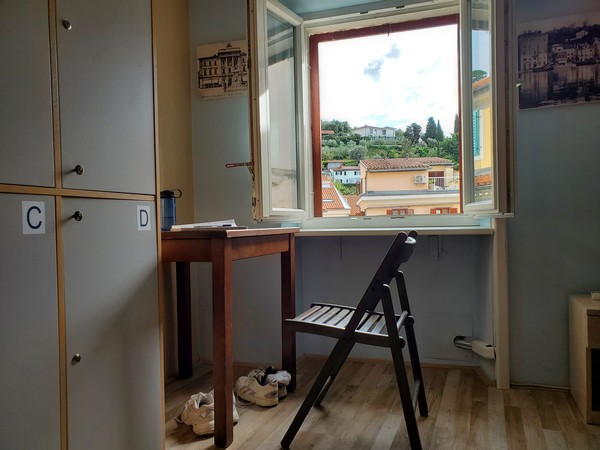
View from the Piran hostel window, where I sat to write in my journal and make Facebook posts. (All hostels have great wifi.)
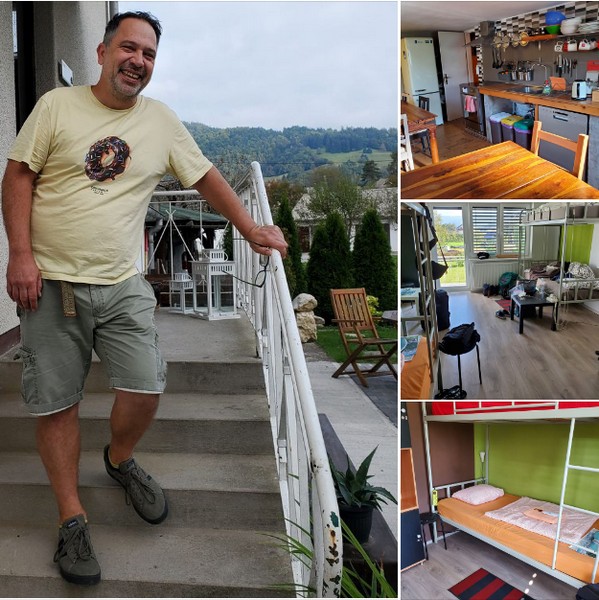
Of all the hostels I stayed at, Hosteller Bled was my favorite. Peaceful, out in the country, and the nicest host, who made every guest feel special and welcome.
Links to my genealogy books
If you are curious about how I've turned my genealogy research into books, you can see an example here. The books are also available in paperback format. I will be making updates once I've processed all of the information I gathered on my trip.